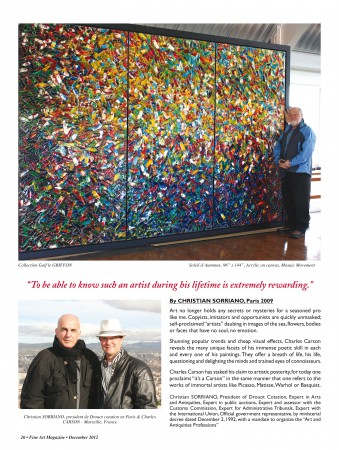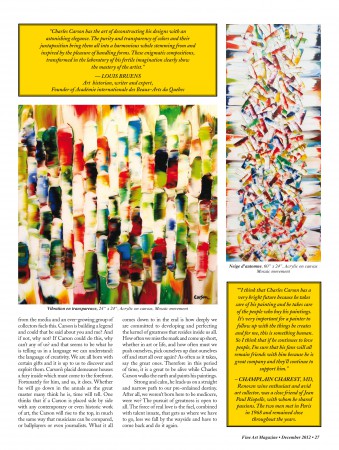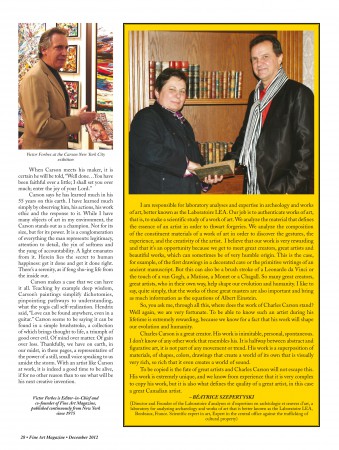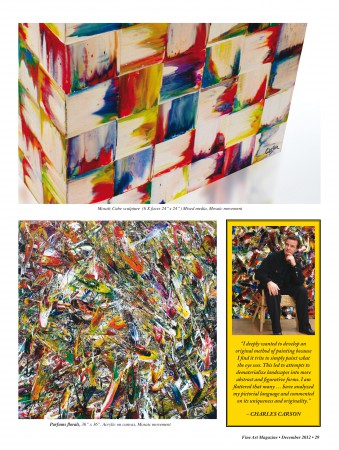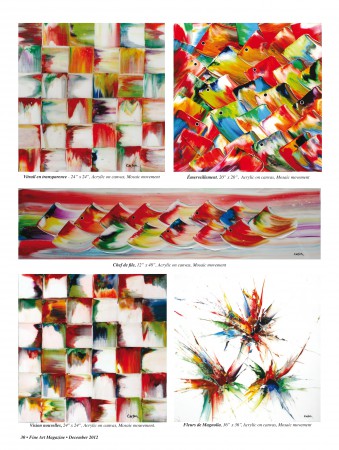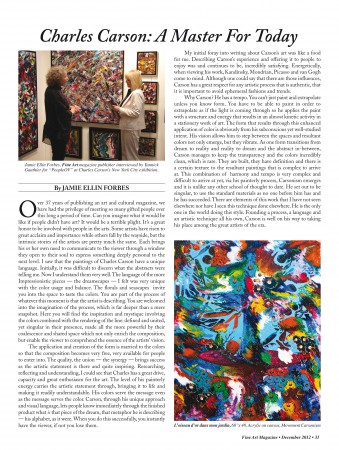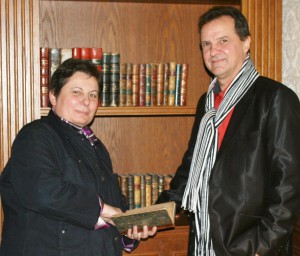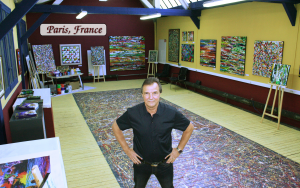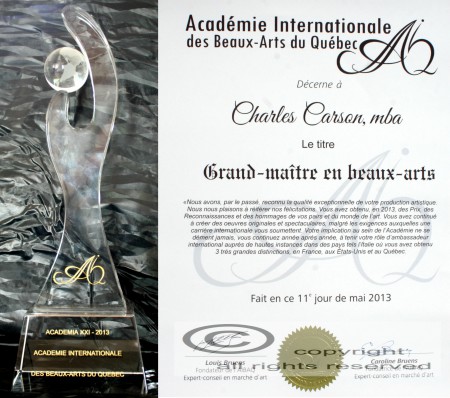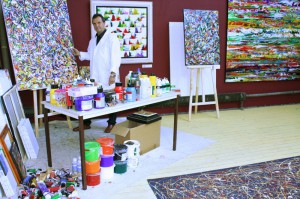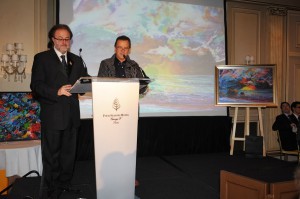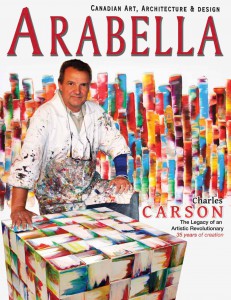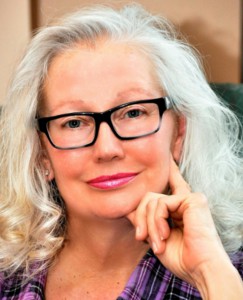note-biographique
now browsing by category
Publication complète
MONDIAL ART ACADEMIA est fière de vous présenter son nouvel Ambassadeur, Monsieur Charles Carson, gmba


Art Mondial Academia
MONDIAL ART ACADEMIA est fière de vous présenter son nouvel Ambassadeur, pour la Floride, Monsieur Charles Carson, grand maître en beaux-arts.
« Pour laisser sa trace dans le monde, Charles Carson a choisi de peindre. Un choix absolu, irrépressible, qui le conduit depuis trente ans à explorer toutes les facettes de son univers intime, à la fois organique et spirituel. Et à nous l’offrir en partage. La révélation de son œuvre devient, pour celui qui est sensible à l’art, une découverte capitale. »
Anne Richer, biographe et journaliste à La Presse depuis 1968.
MULTI DICTIONNAIRE DE LA LANGUE FRANÇAISE

MULTI DICTIONNAIRE DE LA LANGUE FRANÇAISE
6 e Édition, Québec Amérique
Marie-Éva de Villers
CARSONISME n.m.
Bibliothèque nationale du Québec
Bibliothèque nationale du Canada
Technique picturale créée par le peintre québécois Charles Carson. Le carsonisme se caractérise par sa forme d’écriture picturale totalement unique, la transparence, la limpidité et la juxtaposition des couleurs.
Cet onomastisme, sa définition et l’exemple qui l’accompagne sont tirés de Gabriel Martin, Dictionnaire des onomastismes québécois: les mots issus de nos noms propres.
Historique du carsonisme : http://
ISBN 978-2-7644-2931-0
Dépôt légal: 2e trimestre 2015
Bibliothèque nationale du Québec
Bibliothèque nationale du Canada
HONORING HERO OF CREATIVITY, GRAND MASTER CHARLES CARSON
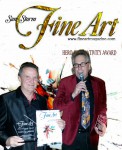
COMMUNIQUÉ DE PRESSE
12 novembre 2015
LES HONNEURS RENDUS À UN «HERO DE LA CRÉATIVITÉ»
LE GRAND MAÎTRE CHARLES CARSON.
ART NEWS, FINE ART MAGAZINE, SINCE 1975
HONORING HERO OF CREATIVITY, GRAND MASTER CHARLES CARSON
« As Hemingway developed a new style of writing that is oft-imitated, never attained, Carson has created a new way of painting that takes a similar heightened position in the mainstream of contemporary art, a form that is universally accessible but impossible to be duplicated by another. A language all his own forever to be known as ‘’Carsonism.’’
Victor Benett Forbes, historien d‟art, écrivain et éditeur du «Fine Art Magazine» depuis 1975 et Charles Carson, Grand maître en Beaux-Arts, Lauréat du Prix «Hero of Creativity 2015» et Créateur du mouvement «carsonisme».
Dans le cadre de son 40e anniversaire (1975 à 2015) M. Victor Bennet Forbes et Jamie Ellen Forbes, historienne et éditrice ont tenus à honorer des lauréats dans plusieurs catégories du domaine des arts.
L’événement a été tenu à New York le lundi 9 novembre 2015 au nouvel édifice du Trump World Tower, 845 United Nations Plaza, New-York, NY. Pour célébrer les 40 ans de publication du Fine Art Magazine un seul artiste en art visuel a été sélectionné parmi tous les artistes américains et internationaux.
Dans la catégorie «Maestro of Art» le lauréat en arts visuels est : Charles Carson le seul artiste ayant occupé la première de couverture du prestigieux magazine à quatre reprises. Il est le seul à avoir réussi cet exploit en 40 ans. Le carsonisme sera donc à l’honneur une fois encore sur la page couverture du numéro de décembre 2015.
Le lauréat : Charles Carson, artiste canadien résidant au Québec, grand maître en beaux-arts. Il célèbrera prochainement ses 38 ans de carrière au Miami Art Show, au Spectrum, et à l’Art Basel de Miami de décembre-janvier et février 2015 et 2016.
Dans les catégories :
1. Hometown Hero : Richie Cannata
https://en.wikipedia.org/wiki/Richie_Cannata
a. Richie Cannata (born March 3, 1949) is an American music producer, multi-instrumentalist and studio owner. He is most notable for playing saxophone in Billy Joel’s band alongside Liberty DeVitto, Russell Javors, and Doug Stegmeyer. After leaving the band in 1981, he opened Cove City Sound Studios in Glen Cove, New York. Artists including Celine Dion, Billy Joel, Jennifer Lopez and Marc Anthony have recorded in Cannata’s studio.
2. Maestro of Art : Charles Carson
a. https://fr.wikipedia.org/wiki/Charles_Carson
b. https://www.charlescarson.com
c. http://www.artacademie.com
d. http://carson.dictionnairedesartistescotes.com/
3. Art and Design Innovator : Christina Cox Museum Curator
a. Christina Cox, director of the National Museum of Catholic Art and History, with an exhibit of bronze angels by Dalí in 2003. CreditMarilynn K. Yee/The New York Times http://www.nytimes.com/2010/05/18/arts/design/18catholic.html?_r=0
4. Music : Dion Di Mucci
a. https://en.wikipedia.org/wiki/Dion_DiMucci
b. Dion Francis DiMucci (born July 18, 1939), better known mononymously as Dion, is an American singer-songwriter whose work has incorporated elements of doo-wop, rock and R&B styles—and, most recently, straight blues. He was one of the most popular American rock and roll performers of the pre-British Invasion era. He had more than a dozen Top 40 hits in the late 1950s and early 60s. He is best remembered for the 1961 singles, « Runaround Sue » and « The Wanderer », written with Ernie Maresca.
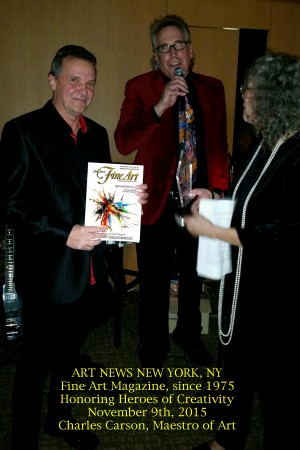 5. Gallerist : Ruth Ann Thorn
5. Gallerist : Ruth Ann Thorn
a. Women In Art, Ruth-Ann Thorn http://www.saltmanart.com/pdf/7-women.pdf
6. Art Book Publisher : Neil Zuckerman
a. Neil Zukerman, Art Book Publisher
b. http://www.zoominfo.com/p/Neil-Zukerman/1463733
7. Artists of the Year : Ed Heck
a. The World of Ed Heck
b. https://fr.foursquare.com/v/the-world-of-ed-heck/504b675ce4b0a294ba234ce3
8. Et Don Oriolo
a. Don Oriolo is known for his work on Felix the Cat: The Movie (1988), Coconut Fred’s Fruit Salad Island! (2005) and Felix the Cat Saves Christmas (2004). See full bio » https://en.wikipedia.org/wiki/Felix_the_Cat
L’artiste-peintre Charles Carson fait honneur au Québec, une fois encore, sur la scène newyorkaise cette fois. C’est toujours avec la même vitalité qu’il repousse les limites de son art.
Merci de votre collaboration
Yanik Gauthier Relationniste pour Charles Carson
438-495-0715
info@charlescarson.com
www.charlescarson.com
-30-
Comme suite à cette hommage de date récente, c’est avec grand plaisir que je vous fais parvenir l’intégralité de la publication originale (en anglais) du reportage paru en 2013 dans le Fine Art Magazine de New York, sous la plume de Victor Bennet Forbes, historien, écrivain et éditeur.
Cet article soulignait les «Heroes of creativity».
Fine Art Magazine – New York City,
USA – Winter 2012/2013
by Victor Forbes
VIEWING A CHARLES CARSON painting is akin to reading a Hemingway short story. A Clean, Well-Lighted Place comes to mind. Both are exquisitely sparse, expertly rendered. Immersed in a collection of Carsons in a gallery or museum is like having a full-length novel unfold right before your eyes. Indeed, the artist himself notes, “My painting is a spontaneous projection of that which I feel. I stand before my canvas like an author before his blank page.” Hemingway, of course, is an undisputed giant of literature while Carson is peaking in mid-career success. The legendary author is known, perhaps to his detriment, as a “man’s man” and the artist, in his way fits that mold. He is strong and confident, succinct in his manner on canvas and in person. Dedicated to his cause, he spares no effort to manifest brilliance in every brush stroke, describing his energy as emerging from an “unexplainable force, trance-like”, that causes one to surpass limitations. As Hemingway developed a new style of writing that is oft-imitated, never attained, Carson has created a new way of painting that takes a similar heightened position in the mainstream of contemporary art, a form that is universally accessible but impossible to be duplicated by another. A language all his own forever to be known as “Carsonism.”
Hemingway captured the popular imagination with a revolutionary sentence structure, almost militaristic in cadence, that somehow translated into stories of great emotional depth blending despair with valor, hopelessness with redemption, and great love with great loss. It is certainly a valid comparison to put these two side-by-side for indeed Carson is an undisputed master, a Maestro of his own form. An originator of a visual lingo that knows no bounds, the compositions soar as his spirit allows. Creativity flies, moving ever-onward, staving off unholy forces. Carson’s paintings strive for perfection like Hemingway’s sentences. There’s not a wasted word nor a misplaced droplet of color. Who paints like this today? Theoretically, it doesn’t matter. Not to Carson because he invented his own very specific mode of expression which involves a very personal creativity. His great gift requires great discipline. Putting the time in, often in solitude, expending the greater part of a 24-hour day painting. However, if science could shine a microscope into a person’s mind and examine his make-up, Carson would outshine many.
UP AND DOWN THE AVENUES, the buildings in New York City, (considered by many to still be the modern day capital of the art world) are decorated with the work of the world’s best-known artists: Stella, Lichtenstein, Oldenberg, Picasso, Kline, Indiana and de Kooning to name but a few. There are massive paintings and sculptures by these and many other all-time greats housed in lobbies, entrances, boardrooms, parks and offices. Attaining the heights reached by such stalwarts would seem to be the goal of most every artist who sets brush to canvas, chisel to stone or ink to paper. So much art has been created over the centuries that to be merely recognized is an accomplishment; to sustain a life of creativity is a triumph. To be hailed as an all-time great and have your work sell in the millions of dollars while you are still alive—that does happen, even if only to a very select group. 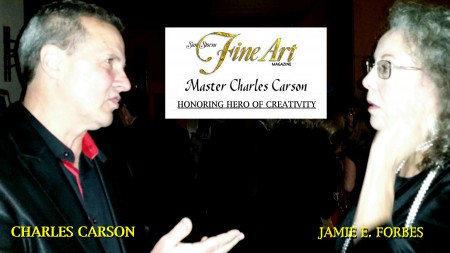 There are a myriad of factors that contribute to entering into that realm, no singular formula. Often greatness is in the eye of the beholder, embellished by simple twists of fate, connections and timing. Pure talent, originality and depth of message will only get you so far. Bob Guccione said that it took a great leap of faith to see his artistic dreams come to life. “There was a time,” said a well-known dealer who has placed works in major museums, “when you could succeed just on the quality of the art alone, but today you could be the greatest artist in the world and if you don’t know the right people and have the right friends, you often remain unknown. You have to be a showman and a promoter on a much bigger scale than even in the day of Dali and Warhol, plus you now have to be technically savvy to capture the world market. The world got smaller. You have to be popular everywhere, not just New York, Paris or Spain.” Art is a product now, not just a creation. It needs to be marketed, auctioned and accepted by the mass media. The factors that bring recognition to some and lack of same to others are not simply intangibles any more. Such elements are taught more in business and marketing programs than in art schools. People studying art today are told by their professors to prepare to starve, to find other ways to use their artistic talents so they can earn a living. But if anyone said this to Charles Carson, he certainly wasn’t listening.
There are a myriad of factors that contribute to entering into that realm, no singular formula. Often greatness is in the eye of the beholder, embellished by simple twists of fate, connections and timing. Pure talent, originality and depth of message will only get you so far. Bob Guccione said that it took a great leap of faith to see his artistic dreams come to life. “There was a time,” said a well-known dealer who has placed works in major museums, “when you could succeed just on the quality of the art alone, but today you could be the greatest artist in the world and if you don’t know the right people and have the right friends, you often remain unknown. You have to be a showman and a promoter on a much bigger scale than even in the day of Dali and Warhol, plus you now have to be technically savvy to capture the world market. The world got smaller. You have to be popular everywhere, not just New York, Paris or Spain.” Art is a product now, not just a creation. It needs to be marketed, auctioned and accepted by the mass media. The factors that bring recognition to some and lack of same to others are not simply intangibles any more. Such elements are taught more in business and marketing programs than in art schools. People studying art today are told by their professors to prepare to starve, to find other ways to use their artistic talents so they can earn a living. But if anyone said this to Charles Carson, he certainly wasn’t listening.
CREATIVE GENIUS
A language all his own forever to be known as “Carsonism.”
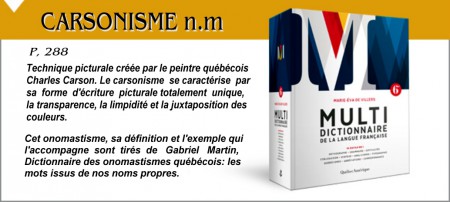
Multi Dictionary of the French language . 6th Edition , Québec Amérique Marie- Éva de Villers Carsonism n.m. Painting technique created by the Quebec painter Charles Carson. The Carsonism is characterized by a totally unique form of pictorial writing , transparency , clarity and juxtaposition of colors. This onomastisme , its definition and example that accompanies it are taken from Martin Gabriel , Quebec onomastismes dictionary : words from our own names .
In the annals of art history, Carson certainly claims a portion of attention. “Nothing,” he says, “can resist the human will. Man must explore all facets of his freedom. The forces within us are instruments of overachievement.” The will to be one with the world, to belong to the stars and to the grains of sand came to him in the same breath. “The mountains, rivers and oceans, all that make up our universe are sacred places more precious than a golden altar.”
The origins of Carson’s style were formulated in the interior of the Catholic churches he visited as a boy. Whether situated in a rich parish or a modest village, the buildings were reflections of baroque tastes dictated by centuries of religious architecture. “It was required,” notes the artist, “that the House of God be the shiniest and most sumptuous of all.”
This decor provided Carson’s first aesthetic feelings and discoveries. These edifices of stone and glass planted the seed of a dream, of a vision of beauty. Where else could a young boy view the transformed light of the sparkling stained glass windows or admire the amazing talent of the artists who sculpted the statutes and painted the images of the Way of the Cross? For Carson, even Sacred music has often consecrated artistic vocations. Silence and contemplation played a subliminal role in creating strong, lasting images.
“As a young child, I attended the religious ceremonies. I observed everything—the “trompe-l’oeil” paintings, the priestly garments embroidered in gold, the gathered crowds. I recall these things to this day with emotion. I was already under their spell when I passed through the heavy church doors. I had a precocious awareness of symbols – dipping my index finger in the fountain made me feel pure and legitimized. For what purpose you may ask? To enter a sumptuous treasure trove. To feast my eyes on everything shiny, the dancing flame of the lanterns, the candelabras. Mingled with the odor of melting wax from the candles, floating in the air, the scent of incense…”
Depending on the hour of day, the light from the exterior would bounce off the plaster saints, bringing their glass eyes to life. The angels of the stained glass windows would become animated. He was transported to another world. “Obviously, only today can I measure the impact these events had on my imagination, in a sublimated and softened memory.”
It is these memories that have served as the basis to create a new style — a completely new pictorial language — that makes an appearance on the scale of artistic values in a way that has nothing to do with the current directions, genres or styles that are mostly found in today’s or any day’s art market. Born in Montreal in 1957, Charles Carson has been devoting himself entirely to his art since 1983. Over the years he has participated in numerous exhibitions in Canada, the United States, Europe, Asia and South America. At the age of 33, Charles made his own discovery of Latin America and lived in Columbia for nearly 10 years. Here he produced extraordinary and exotic works, yet he always retained his sensitivity, depth and vivacity, as well as the dynamic range and variety of composition. Yet his paintings still hint at the winters of his youth — those gray storm-clouds that visit his works and give them a striking three-dimensional feel. “Although born in Montreal, I spent many years living in remote country settings where.
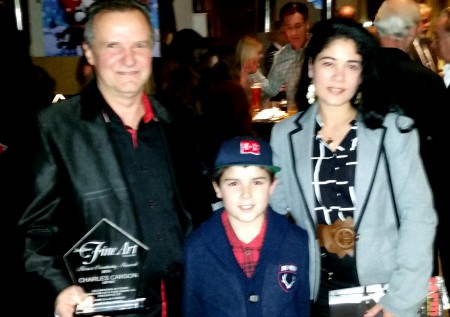 “Today I am no longer preoccupied by the foibles of life. To the contrary, I allow myself to go with the flow and to let my imagination run free. It is the best way to face life.”
“Today I am no longer preoccupied by the foibles of life. To the contrary, I allow myself to go with the flow and to let my imagination run free. It is the best way to face life.”
I pursued my chromatic search before moving to South America. I wanted to live new experiences, artistically as well as culturally. I developed a passion for skin-diving and gained artistic inspiration from scenes on the ocean floor, from the multitude and variety of colors to the cathedral light produced by the sun piercing the ocean surface. One day, I nearly lost my life during a skin-diving expedition. The whirlpool that nearly swept me away did not affect my love for open water.”
Be it the roar of an ocean or the flow of a river, the excitement of the potential danger manifested in broad strokes of the pallet knife, in blue sheaves and successive waves, to form the pictorial theme of a marine scene in the Carsonism or mosaic movement.
What creative energy !
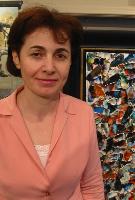
Arévik Vardanyan,
conseillère en art, muséologue.
Maîtrise en histoire de l’art de l’Université d’état pédagogique d’Erevan, Arménie en 1989.
DESS (Diplôme d’étude supérieure spécialisée) en muséologie de l’Université Laval, Qc/2003.
“…one must recognize the undeniable talent of Charles Carson for his exceptional sense of chromatic harmony: his blue inspires dreams, his red surprise the eye, his yello illuminates the heart…”
“A chromatism that is at once harmonious and audacious, a play of transparencies and depths, dynamic composition and a continually renewed sense on innovation. Here is the winning recipe that propulses the artist from one success to the next.” /2003
Arévik Vardanyan, Advisor in art and museology
Influenced through his admiration of van Gogh, Cézanne and Turner, at thirty-three, Carson spent time in Latin America where the spirit of inspiration gleaned from Columbian and other landscapes led him to a new personal era of expression through his imagery. Carson made a name for himself there, where he held numerous exhibitions and developed an amicable relationship with Fernando Botero. While many native artists left for Europe and America in search of fame and fortune, Carson found international recognition from his stay in South America. The influence the painters, topography and people of Colombia exerted upon the young Carson, and the vibrant and ancient culture that he absorbed, is evident in much of his work today.
In recognition of his contribution, a life-size statue of the artist in bronze has been on view in a major Cartagena public building since 1997. He also created a monumental mural entitled El Caballo del Mar for the main hall of Cartagena’s principal airport, and he executed another mural entitled Yo hice lo que tu querias for the Church in Santo Domingo (a renowned Heritage Monument).
Carson’s travels were the impetus for his deep feelings regarding the social and ecological problems of today’s societies. His fascination with and love of nature occupies a primary place in his creations. A major turning point in his work were tropical scenes combining colors usually associated with a Caribbean sunset.From this starting point, he produces even greater depth and power than would seem conceivable from the paint. What technique manages to get such verve from color, and yet such detail? Again, it can only be described as “Carsonism.”
There is one constant in all of the analyses and for each of the experts and art historians and it is this: Carson’s work generates energy, an unparalleled “joie de vivre” which is reflected in a mastery of forms and transparency of colors.
His physical control is always evident and he paints in bold strokes of incredibly vibrant color yet with a delicacy and intimacy that touches an emotional chord in the viewer. The making one of the strength and softness is the basis of the resultant beauty. This masterful technique has gained the artist a legion of collectors and admirers internationally and his works are sought after by serious collectors around the world.
What is especially interesting and exciting about Carsonism is the fact that he was determined from the onset to contain his desire to be recognized as an exhibiting artist until he was confident that his body of work — from the very beginning — would be unique in a world where imitation, appropriation and other flattering forms of self-indulgence were and still are rampant. Carson’s approach was like that of a monk, or a martial artist in training who would not come out to do battle until totally confident that the results would end in victory. Of course, there are no guarantees in this life of anything, yet Carson took that leap of faith, based upon years of study, trial and error and inspiration.
Early in his career, the artist employed traditional techniques, gaining inspiration from his environment. His early figurative works left him unsatisfied and he started to lean towards a semi-figurative and extremely personal style of painting. This technique, along with his unique pictorial language rapidly affirmed themselves and his talent was revealed with each new creation.
The artist produces extraordinary works that exhibit sensitivity, depth and liveliness, as well as dynamism and variety of composition that characterize his work. “From an early age, I was in search of other sources of inspiration. I was born with a personality that was exuberant, imaginative and inventive. My inherent curiosity instilled in me the desire to delve beyond a simple explanation of how something worked. My persistence helped me to find answers to many questions – not necessarily the best answers or those that were for my own good.
Carson’s imagination led him to a sense of a place beyond, higher, farther, deeper. He was seeking out a unique destiny with other universes to discover. Hence his fascination with the underwater life, so evident in many of his paintings and other universes perhaps yet to be discovered. His goal was to create a life for himself as an artist that was not subject to anyone’s authority. Refusing to follow a predetermined path, he greatly preferred the unknown.
In international art exhibitions, Carson’s work stands alone. His stalls are sanctuaries in which he and the viewers can escape to a tranquil place, inhabited with a realistic presence of the aforementioned storm clouds but marked with a placidity, a bouquet if you will of sweetness and softness. The flowers, the fish and the birds are created with a power reflected the divinity of their creation, represented by an artist who considers it his right to transform a concrete image of the eye into something different guided by his innate sensitivity and an artistic gift that allows him to incorporate into his works personal feelings, to share his universe of color, dreams, thoughts and emotions.
Carson says, “The art of painting is to forget the subject matter; it no longer exists, relegated to the shadows, lights and reflections of color.” van Gogh may have said the same thing. They both take the reality of a scene and transform it into their own very specific concoction that somehow, when put together, is a coherent, emotional and brilliant force. Watching Carson at work is like watching a tiger in his natural habitat. Stalking his prey, the artist is firm in his quest. The quest being perfection, that is to make something, lterally out of nothing that has an impact on one’s emotions and beyond that, to get the world to recognize his creations as valuable entities in the continuum of art history. It may be legitimately asked, how many artists are so instantly recognizeable that critics had to come up with a name, i.e. a school of thought even, for the produced work. That Carsonism has caught on is not just a freak show or the work of a great publicist. The fact is he has taken all the schools that have come before him, blended them into his subconscious and developed his art form.
Carson is far from one-dimensional and a follower of no one. He would not exhibit a single painting until he was certain he had created an approach that could only be attributed to him. It came after years of contemplation, hours of experimentation and decades of polishing a format that came to be known as Carsonism. How many artists are so attached to a style that the world recognizes it by the artist’s own name? Was there an artist named Impression? Or Modern? No. Carson created his style, his language and whether it was because he was ostracized in gym class for lack of athletic ability, or because his family didn’t send him to a fine art finishing school, or whatever the reason, Carson put himself in front of that blank canvas, or whatever else he was working on, and made it resonate with his own words. It’s a language we all can understand, no matter the country of our origin and it is a lot easier to communicate internationally in this manner
Carson a discovery … “Carsonism”, 1992
“In my capacity as art expert and historian, it has given me great pleasure to examine a significant quantity of the artist’s paintings. I was struck by their freshness, dynamism and rhythm — the freshness and vivacity of the palette, the dynamism and diversity of the compositions, the rhythm that animates each segment of his paintings, much like the best jazz piece whose sense of improvisation opens up the instinctive structure of the melody and animates it with its syncopated syntax. If one prefers, it can be compared to a Scarlatti sonata or a Vivaldi concerto whose variations and modulations define the structure and subtlety of the piece.”
Carson gives his paintings a depth that makes the best demonstrations of perspective pale in comparison…
none of contemporary art’s well known “isms” seem appropriate and I must resign myself (with great satisfaction I might add) to naming this new movement: CARSONISM !”
Guy ROBERT, (1933-2000)
Founder of the Musée d’Art Contemporain de Montréal, art historian, writer and editor,
author of an analysis in which “Carsonism” was described in glowing term. “Carson to the ism”. 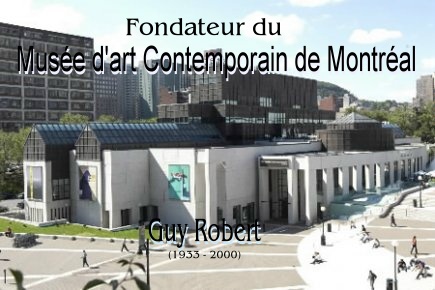
“Hero of Creativity” – Let the next writer come up with a better catch phrase, for now that is a standard they have to top.
What Carson has done is invent an approach to life that is that of a warrior wielding a paintbrush for a sword, A ninja in paint. His mannerisms are disciplined. There is no waste or obfuscation. Everything is crystalline. Shining, bright and brilliant, even in the way he operates the front end of his business, travels to exhibits, sets them up, prepares the wall space of an exposition so that every inch is maximized. He is not going down without a fight and every aspect of his creativity is measured.
Hemingway’s sentences are short and sweet. Could he write like Fitzgerald or Faulkner or Steinbeck? Maybe. Pollock could draw. He could render so that when a fool looks at a drip masterpiece and says, “My kid could do that,” well maybe. But he certainly couldn’t knock out a realistic charcoal passable sketch which gave Pollock credibility with the so-called cognoscenti.
Therefore one might ask, could Carson create in another manner? Maybe is the answer again. But it is clear he never wanted to be anything other than an original. What is true about Carson and many other great artists is that they put the time in, often in the deepest of solitudes, to accomplish their vision. This is the part that is most daunting for a human being. Have you read that the author of numerous best-sellers, Harold Robbins, with all the money he needed, had one room painted in his home totally black, with only a desk, typewriter and single pointed spotlight attached from the ceiling to shine over his shoulder onto the matter at hand, in his case words on paper? Carson’s fierce spirit of determination and invention is akin to this. Even the small paintings—not to be confused with a minor work because none of Carson’s work can be deemed minor — contribute to the thematic line of his vision. The point may be not only to create a new language, but to say something in it by taking the alphabetical fragmentation of each word and making them into a coherent statement of power. An artist uses various tools to perform such a task and Carson’s experiments (successes and failures) with glass and kilns and explosions and his years of sitting in Catholic churches as a youth in rich and poor parishes of his native Quebec and being enthralled by the imagery and refractions of light on and through the glass are well-documented.
It is an artistic and creative fact of life that Carson goes about his work with a precision that is almost unfathomable.
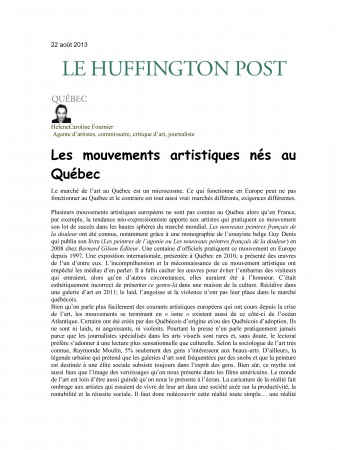 Carsonism came about through his adaptation of the aforementioned media into application by brush on canvas. Not since Pousette-Dart has anyone done this with such power and coherence. While Pousette-Dart built his paintings up with oil, sometimes over the course of 30 years, and created embryonic universes within and without the rules of art — brilliant universes of revolving natural forms that from a distance as well as from up-close reveal secrets of creation unknown to most mortal men — Carson, in devising his approach, takes a similar path to a similar result with a voice all his own. In addition to his soulful work, what I loved best about Pousette-Dart comes from a story his wife Evelyn related just before his one man show at New York’s Metropolitan Museum of Art.
Carsonism came about through his adaptation of the aforementioned media into application by brush on canvas. Not since Pousette-Dart has anyone done this with such power and coherence. While Pousette-Dart built his paintings up with oil, sometimes over the course of 30 years, and created embryonic universes within and without the rules of art — brilliant universes of revolving natural forms that from a distance as well as from up-close reveal secrets of creation unknown to most mortal men — Carson, in devising his approach, takes a similar path to a similar result with a voice all his own. In addition to his soulful work, what I loved best about Pousette-Dart comes from a story his wife Evelyn related just before his one man show at New York’s Metropolitan Museum of Art.
“Richard told the curator that if his banner outside was one inch smaller than Picasso’s, they could forget about the show.
How did you grow into becoming an artist?
I did not attend a fine arts school despite my desire to do so. Neither my family nor social environment fostered such pursuits.
Regardless, this did not inhibit my perpetual search for a pictorial language.
The “still life” paintings that I was working at during this time were academic exercises. The subject matter was of little importance. These studies allowed me to explore space and depth, two elements that would be crucial to my future work.
I was also doing glass etching with a diamond tip. By superimposing layers of glass, I produced the three dimensional effect that I was looking for. I experimented with various processes, including: collage, copper, paint and grass. The inspiration came from my discoveryof the magnificent Lalique crystal in Europe.
Although this creative technique was received positively, I was not through searching. I continued to perfect my technique for juxtaposing colors, using acrylic to create vivid abstract forms. On a linen canvas, I spread pieces of colored glass, complemented by strokes of acrylic to create an impression of haut-relief. Then, to make the colors explode, I highlighted them with an ultra bright lacquer. I was fascinated and seduced by the art of the master glassmakers of Murano and to emulate their artistry, I heated huge, multi-level ceramic ovens, created moulds and inserted my glazed pieces at a temperature of 2,000 to 3,000 degrees.
What kind of artist tools did you employ?
I desperately wanted to reproduce with paint, the textures, forms and transparency of stained glass windows. I used oils, acrylics, pastels and charcoals in my artistic process. All recovery areas served to advance my experimentations for adherence and durability.
I spared no effort during these years of experimentation with special effects and contemporary art. I would drop bags of paint from the roof of the house and rush to see the splatters they created on the sidewalk! Or I would use a drill to spin a panel I had coated with different colors of acrylic paint. Not to mention the balloon filled with paint that I would burst over a canvas… I even used an old bicycle wheel to spread colors on a canvas to see the effect it produced.
Once, I nearly burned my house down experimenting with a special lacquer. This misadventure brings a smile today. I learned that paint and fire do not make good partners. In my efforts to recreate the “Murano effect”, the wooden roof of my studio as well as the work in progress were reduced to ashes.
This incident, as is often the case with fortuitous scientific experiments, allowed me to perfect a mixture of glass and epoxy finished with a blowtorch.
I lost count of the number of plaster moulds that were sacrificed for the cause. Not to mention the kilos of glass tiles used during the mosaic experiments. Since those days, I have used an acrylic paint that is more malleable for the textures, dries more quickly and allows for multiple layering of color. My first subjects were bouquets of flowers, done in an abstract style.
For me, the message necessarily had to be communicated with the proper tools. I strove to find a language that was personal. It was both a quest and a challenge.
MOSAIC MOVEMENT
“Charles Carson’s painting is divided into two approaches which are both distinct and complimentary. One was even named Carsonism by some art critics and historians. This approach is not easy to describe, but generally speaking it is composed of an infinite succession of slightly oblique strokes which, on the surface, add maximum energy to our perception of theme and subject, with the whole being animated through subtle transparencies which are quite sensational, creating an impression of depth and color. It’s like an incessant flow of particles — all the same size — which sweep the paint with fascinating, even disconcerting regularity. Carson’s second approach is simply that of mosaic. As its name suggests, we find a fragmentation of form and surface characteristic of the mosaic style. In both instances the artist endows the surface of his canvasses with great energy, creating an altered state in which his powerfully metaphorical universe is expressed.”
Robert Bernier, art historian
Magazine Parcours, The Advisor of Arts – Winter 2004
While nowhere nearly as famous or collected as Picasso, at the recent Armory art fair, the Poussette-Dart’s were flying off his gallery’s wall at about $400k for a 30” x 40”. Mid-show, I heard the dealer call Evelyn asking for more.
That, say more than a few scholars and critics, is how it will be for Carson. He is young enough to attain that level; also skilled enough and also original enough. He’s going to France for three years to concentrate on making museum pieces and they will have to think hard to come up with better a headline than this: “Carson to the ism” and “Hero of Creativity.” Let the next writer come up with a better catch phrase, for now that is a standard they have to top.
Whether fighting off the gym class bullies or working his way out of a cylindrical spout of water in which he almost drowned, Carson’s paintings show a power that opts for life. In the Carsonism pieces, he recreates natural scenes with deconstructionist vengeance, the three dimensionality of his minute dollops of sculpted paint surround the spaces, fill the emptiness. That’s Carson to the ism. Clean, well-lit. Fully functional but esoteric.
“Oh, there’s a bird amidst all that,” a viewer would note. Or a fish. Or a reflection from light cascading to the depths of the sea or a natural burst of energy from a trip up the Amazon. Carson has been there and done that and the main thing is that he gives these scenes, these segments, these minute conglomerations of acrylic a glazed energy so that when they are combined into one unit you see exactly what he wants you to see. The veil is opened, but the real question is: “to what?”
That’s where the art critics come in. They know and they have seen. Carson isn’t saying. It was more than enough for him to invent this style and then to top it off with what he calls the “Mosaic Movement.” This is a whole other field of dreams, but if you could chop off a bunch of square inches on a mosaic and drop it into a canvas of Carsonism, they would work together. Blend somehow in unity. After all, wasn’t it the American poet/philosopher Eli Siegel, founder of Aesthetic Realism, who was famous for his statement, “Beauty is the making one of opposites.”?
Yes, it is an artistic and creative fact of life that Carson goes about his work with a precision that is almost unfathomable. Look at a masterwork by Vasarely. A modern viewer could not imagine anything being executed like that without the help of a computer generated graphic. Carson’s pieces are puzzles that come together as a triune entity of paintbrush, palette and painter as One and they must become as one integrated into the format necessary to produce masterful depictions of whatever the artist envisions. They work as if a Sumi-e drawing because Carson makes no sketches, no pre-conceived notions. Just step up the plate and hit the ball out of the park.
As successful as he is, there is a hunger to Carson that seems to be unquenchable. An insatiable thirst to do more, to do better, to be the standard by which all other artists are measured.
In this world, there is a train to glory and Carson is a passenger, riding close to the front. John Dunne made this statement for eternity: “No man is an island” and that’s for sure. “It matters not for whom the bell tolls, it tolls for thee.” Carson sees this and his stance as an artist of great individuality is tempered by his compassion for the earth and his fellow man. His paintings are manifestations of his thoughts and deeds, his hopes for a better world, a just world, a beautiful world of peace and harmony. Knowing this about him further fuels our interest in his creative vortex — a whirling mass of sensibility and sensitivity to not only God’s love but our obligation to our Creator to return favors granted. This is the meaning of the creative life in which we strive for greatness, recognition, riches and fame (of course) but in doing so, seek to bring mankind along with us. It’s a long train running, this train for glory, and the sensitive ones are prone to fall by the wayside. Carson tempers his passion with great control, seemingly, in his work and this may just be the key to unlocking the magic in his imagery and in his reason for being. Getting his message out to as many as possible is a motivating force in his life at this time and recognition from the media and an ever-growing group of collectors fuels this. Carson is building a legend and could that be said about you and me? And if not, why not? If Carson could do this, why can’t any of us? and that seems to be what he is telling us in a language we can understand: the language of creativity. We are all born with certain gifts and it is up to us to discover and exploit them. Carson’s placid demeanor houses a fury inside which must come to the forefront. Fortunately for him, and us, it does. Whether he will go down in the annals as the great master many think he is, time will tell. One thinks that if a Carson is placed side by side with any contemporary or even historic work of art, the Carson will rise to the top, in much the same way that musicians can be compared, or ballplayers or even journalists. What it all comes down to in the end is how deeply we are committed to developing and perfecting the kernel of greatness that resides inside us all. How often we miss the mark and come up short, whether in art or life, and how often must we push ourselves, pick ourselves up dust ourselves off and start all over again? As often as it takes, say the great ones. Therefore in this period of time, it is a great to be alive while Charles Carson walks the earth and paints his paintings.
Strong and calm, he leads us on a straight and narrow path to our pre-ordained destiny. After all, we weren’t born here to be mediocre, were we? The pursuit of greatness is open to all. The force of real love is the fuel, combined with talent innate, that gets us where we have to go, less we fall by the wayside and have to come back and do it again.
“Charles Carson presents us with magnificent visual richness. The viewer must learn to read – consciously or not – the scenes or subjects being proposed. Carson interprets and transposes with great strength and subtlety. An attitude that within the visual arts world, precedes and follows all major careers.” – 1993 /Jacques de Roussan, (1929-1995)
Historian, publisher, writer and art consultant.
« My first inspirations for the Carsonisme and mosaic movements came from Quebec. The stained glass windows of our many churches as well as the color and transparency of the province’s spectacular autumn scenes fascinated me. The image of autumn leaves reflecting in the river culminated in the mosaic movement.
In my younger years, I was fascinated by sunligh-t shining through stained glass windows. This image has always had a hold of my imagination which probably explains why I have always sought to replicate this transparency and luminosity and to create the effect of light coming from behind the canvas. Both the Carsonism and mosaic movements are reflections of water in motion.” — Charles Carson
“To be able to know such an artist during his lifetime is extremely rewarding.”
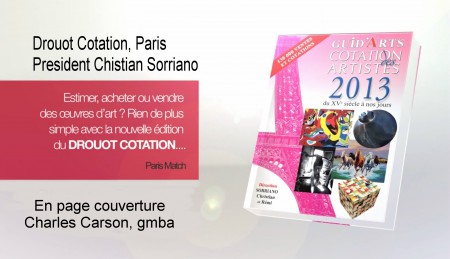 By CHRISTIAN SORRIANO, Paris 2009
By CHRISTIAN SORRIANO, Paris 2009
Art no longer holds any secrets or mysteries for a seasoned pro like me. Copyists, imitators and opportunists are quickly unmasked; self-proclaimed “artists” daubing in images of the sea, flowers, bodies or faces that have no soul, no emotion.
Shunning popular trends and cheap visual effects, Charles Carson reveals the many unique facets of his immense poetic skill in each and every one of his paintings. They offer a breath of life, his life, questioning and delighting the minds and trained eyes of connoisseurs.
Charles Carson has staked his claim to artistic posterity, for today one proclaims “it’s a Carson” in the same manner that one refers to the works of immortal artists like Picasso, Matisse, Warhol or Basquiat.
Christian SORRIANO, President of Drouot Cotation, Expert in Arts and Antiquities, Expert in public auctions, Expert and assessor with the Customs Commission, Expert for Administrative Tribunals, Expert with the International Union, Official government representative, by ministerial decree dated December 2, 1992, with a mandate to organize the “Art and Antiquities Professions”
“Charles Carson has the art of deconstructing his designs with an astonishing elegance. The purity and transparency of colors and their juxtaposition bring them all into a harmonious whole stemming from and inspired by the pleasure of handling forms. These enigmatic compositions, transformed in the laboratory of his fertile imagination clearly show the mastery of the artist.”
LOUIS BRUENS, (1928 – 2013) Art historian, writer and expert,
Founder of Académie internationale des Beaux-Arts du Québec
Victor Forbes at the Carson New York City exibition
When Carson meets his maker, it is certain he will be told, “Well done…You have been faithful over a little; I shall set you over much; enter the joy of your Lord.”
Carson says he has learned much in his 55 years on this earth. I have learned much simply by observing him, his actions, his work ethic and the response to it. While I have many objects of art in my environment, the Carson stands out as a champion. Not for its size, but for its power. It is a conglomeration of everything the man represents: legitimacy, attention to detail, the yin of softness and the yang of accountability. A light emanates from it. Herein lies the secret to human happiness: get it done and get it done right. There’s a serenity, as if feng shu-ing life from the inside out.
Carson makes a case that we can have it all. Teaching by example deep wisdom, Carson’s paintings simplify dichotomies, pinpointing pathways to understanding, what the yogis call self-realization. Hendrix said, “Love can be found anywhere, even in a guitar.” Carson seems to be saying it can be found in a simple brushstroke, a collection of which brings thought to life, a triumph of good over evil. Of mind over matter. Of gain over loss. Thankfully, we have on earth, in our midst, in these pages, a representative of the power of a still, small voice speaking to us amidst the storm. With an artist like Carson at work, it is indeed a good time to be alive, if for no other reason than to see what will be his next creative invention.
Victor Forbes is Editor-in-Chief and co-founder of Fine Art Magazine, published continuously from New York since 1975
Laboratory LAE for analyzing archaeology and works
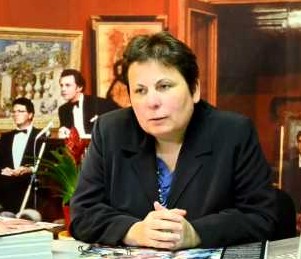
Béatrice Szepertyski, directrice et fondatrice du Laboratoire LAE Centre d’analyses et d’expertises en archéologie et œuvres d’art de grands maîtres, implantés dans le quartier des Chartrons, en plein cœur de Bordeaux.
I am responsible for laboratory analyses and expertise in archeology and works of art, better known as the Laboratoire LAE. Our job is to authenticate works of art, that is, to make a scientific study of a work of art. We analyze the material that defines the essence of an artist in order to thwart forgeries. We analyze the composition of the constituent materials of a work of art in order to discover the gestures, the experience, and the creativity of the artist. I believe that our work is very rewarding and that it’s an opportunity because we get to meet great creators, great artists and beautiful works, which can sometimes be of very humble origin. This is the case, for example, of the first drawings in a decorated cave or the primitive writings of an ancient manuscript. But this can also be a brush stroke of a Leonardo da Vinci or the touch of a van Gogh, a Matisse, a Monet or a Chagall. So many great creators, great artists, who in their own way, help shape our evolution and humanity. I like to say, quite simply, that the works of these great masters are also important and bring as much information as the equations of Albert Einstein.
So, you ask me, through all this, where does the work of Charles Carson stand? Well again, we are very fortunate. To be able to know such an artist during his lifetime is extremely rewarding, because we know for a fact that his work will shape our evolution and humanity.
Charles Carson is a great creator. His work is inimitable, personal, spontaneous. I don’t know of any other work that resembles his. It is halfway between abstract and figurative art, it is not part of any movement or trend. His work is a superposition of materials, of shapes, colors, drawings that create a world of its own that is visually very rich, so rich that it even creates a world of sound.
To be copied is the fate of great artists and Charles Carson will not escape this. His work is extremely unique, and we know from experience that it is very complex to copy his work, but it is also what defines the quality of a great artist, in this case a great Canadian artist.
– BÉATRICE SZEPERTYSKI (Director and Founder of the Laboratoire d’analyses et d’expertises en archéologie et oeuvres d’art, a laboratory for analyzing archaeology and works of art that is better known as the Laboratoire LAE, Bordeaux, France. Scientific expert in art, Expert in the central office against the trafficking of cultural property)
“I deeply wanted to develop an original method of painting because I find it trite to simply paint what the eye sees. This led to attempts to dematerialize landscapes into more abstract and figurative forms. I am flattered that many … have analyzed my pictorial language and commented on its uniqueness and originality.” – CHARLES CARSON
Charles Carson: A Grand Master For Today
Over 40 years of publishing an art and cultural magazine, we have had the privilege of meeting so many gifted people over this long a period of time. Can you imagine what it would be like if people didn’t have art? It would be a terrible plight. It’s a great honor to be involved with people in the arts. Some artists have risen to great acclaim and importance while others fall by the wayside, but the intrinsic stories of the artists are pretty much the same. Each brings his or her own need to communicate to the viewer through a window they open to their soul to express something deeply personal to the next level. I saw that the paintings of Charles Carson have a unique language. Initially, it was difficult to discern what the abstracts were telling me. Now I understand them very well. The language of the more Impressionistic pieces — the dreamscapes — I felt was very unique with the color usage and balance. The florals and seascapes invite you into the space to taste the colors. You are part of the process of whatever this moment is that the artist is describing. You are welcomed into the imagination of the process, which is far deeper than a mere snapshot. Here you will find the inspiration and mystique involving the colors combined with the rendering of the line: defined and united, yet singular in their presence, made all the more powerful by their coalescence and shared space which not only enrich the composition, but enable the viewer to comprehend the essence of the artists’ vision.
The application and creation of the form is married to the colors so that the composition becomes very free, very available for people to enter into. The quality, the union — the synergy — brings success as the artistic statement is there and quite inspiring. Researching, reflecting and understanding, I could see that Charles has a great drive, capacity and great enthusiasm for the art. The level of his painterly energy carries the artistic statement through, bringing it to life and making it readily understandable. His colors serve the message even as the message serves the color. Carson, through his unique approach and visual language, lets people know immediately through the finished product what is that piece of the dream, that metaphor he is describing — his alphabet, as it were. When you do this successfully, you instantly have the viewer, if not you lose them.
My initial foray into writing about Carson’s art was like a food for me. Describing Carson’s experience and offering it to people to enjoy was and continues to be, incredibly satisfying. Energetically, when viewing his work, Kandinsky, Mondrian, Picasso and van Gogh come to mind. Although one could say that there are those influences, Carson has a great respect for any artistic process that is authentic, that it is important to avoid ephemeral fashions and trends.
Why Carson? He has a tempo. You can’t just paint and extrapolate unless you know form. You have to be able to paint in order to extrapolate as if the light is coming through so he applies the paint with a structure and energy that results in an almost kinetic activity in a stationery work of art. The form that results through this enhanced application of color is obviously from his subconscious yet well-studied intent. His vision allows him to step between the spaces and resultant colors not only emerge, but they vibrate. As one form transitions from dream to reality and reality to dream and the abstract in-between, Carson manages to keep the transparency and the colors incredibly clean, which is rare. They are built, they have definition and there is a certain texture to the resultant paintings that is complex to arrive at. This combination of harmony and tempo is very complex and difficult to arrive at yet, via his painterly process, Carsonism emerges and it is unlike any other school of thought to date. He set out to be singular, to use the standard materials as no one before him has and he has succeeded. There are elements of this work that I have not seen elsewhere nor have I seen this technique done elsewhere. He is the only one in the world doing this style. Founding a process, a language and an artistic technique all his own, Carson is well on his way to taking his place among the great artists of the era.
Source: Fine Art Magazine, New York, Winter 2012/2013
Publication: http://issuu.com/carsonisme/docs/fine_art_magazine_featuring_master_carson
DOCUMENTAIRE SUR L’ARTISTE: http://youtu.be/ZkoFf2S8gHg
Historique du « carsonisme » : https://www.charlescarson.com/?page_id=5587
Charles Carson reçoit le Prix «Héros de la créativité»
ART. L’artiste-peintre Charles Carson fait honneur au Québec sur la scène new-yorkaise et reçoit le prix «Héros de la créativité», un prix prestigieux remis dans le cadre du 40e anniversaire du «Fine Art Magazine». Montréalais de naissance, ce dernier réside à Prévost.
L’événement s’est tenu début novembre au nouvel édifice du Trump World Tower. Pour ce 40e anniversaire, les éditeurs ont tenu à honorer des lauréats dans plusieurs catégories du domaine des arts. Un seul artiste en art visuel a été sélectionné parmi tous les artistes américains et internationaux. Par ailleurs, Charles Carson, le lauréat en arts visuels dans la catégorie «Maestro of Art», est le seul artiste ayant occupé la première de couverture du prestigieux magazine à quatre reprises. Le carsonisme, la technique picturale qu’il a créée est donc à l’honneur une fois encore sur la page couverture du numéro de décembre 2015.
Le carsonisme est né au début des années 1990, alors que la forme d’écriture picturale unique au monde de l’oeuvre de Carson était reconnue par l’historien et expert en art, Louis Bruens.
En outre, Christian Sorriano, le président de Drouot cotation à Paris, expert en art et en antiquités a dit des œuvres du maître incontesté des couleurs: «On dit c’est un Carson, comme on dit c’est un Picasso, un Matisse, un Warhol, un Basquiat et tous les autres artistes immortels».
Rencontre
Charles Carson est un homme occupé. Il gère de nombreuses galeries au niveau international, et partage sa vie entre ses quatre ateliers. À Paris, en Amérique du Sud, en Floride et celui de Prévost, le lieu où nous l’avons rencontré. Il se préparait à partir pour s’établir pour trois ans en Floride, le haut lieu du marché international des arts.
«Je suis touché que, parmi les artistes des 40 dernières années, ce soit un artiste québécois qui remporte le prix. C’est un très bel honneur, un bel hommage», nous partage-t-il. Le peintre et sculpteur autodidacte a remporté de très nombreux prix, dont huit médailles d’or au niveau international. «Recevoir des prix, ça fait plaisir, je suis fier, mais ma passion c’est de peindre et de mettre de la joie dans chacune des maisons», nous confie-t-il.
Il nous raconte l’histoire, qui l’a beaucoup touché, de cet homme qui n’avait plus que six mois à vivre qui lui avait confié que le fait de regarder son tableau était ce qui lui qui lui permettait de passer sa journée.
«Pour moi c’est très touchant et je me suis dit: j’ai accompli ma mission! Le côté humain est très important», ajoute celui qui trouve aussi son inspiration à travers ses voyages. Il a séjourné pendant 10 ans en Colombie et s’est promené un peu partout dans le monde.
Il nous confie qu’il est arrivé à Prévost il y a une douzaine d’années. «Mes parcours arrivent toujours par accident.» Il ne devait pas y rester. «Je devais partir pour quatre mois à l’extérieur du pays.» Finalement, il achètera la maison qu’un ami vendait. « J’aime le bord de l’eau. J’ai toujours vécu proche de l’eau, la mer, une rivière, un lac, pour moi l’eau est importante».
Charles Carson célèbrera prochainement ses 38 ans de carrière au Miami Art Show, au Spectrum, et à l’Art Basel de Miami de décembre-janvier et février 2015 et 2016.
EXPOSITION – MAÎTRE CHARLES CARSON – 17 sept au 16 oct 2014 – Courbevoie, Paris
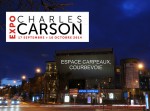
Exposition de Charles Carson, gmba, du 17 sept au 16 oct 2014 à Courbevoie, Paris, France
LE PARISIEN, 08 octobre 2014
C’est une exposition haute en couleurs que propose ce mois-ci l’Espace Carpeaux avec les oeuvres de Charles Carson. Ce peintre canadien qui a installé son atelier à Courbevoie, entre le centre-ville et La Défense, est connu pour avoir imposé son propre style, le Carsonisme. Ses peintures abstraites et très colorées sont toujours extrêmement vivantes grâce notamment aux impressions de mouvement qu’elles dégagent. Quarante tableaux originaux et inédits sont proposés au public dans le cadre de cette exposition.
Jusqu’au 16 octobre à l’Espace Carpeaux, angle boulevard Aristide-Briand et boulevard de Verdun à Courbevoie, Région Parisienne.
DICTIONNAIRE DES ONOMASTISMES QUÉBÉCOIS
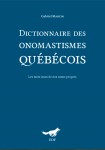
DICTIONNAIRE DES ONOMASTISMES QUÉBÉCOIS
Les mots issus de nos noms propres.
« CARSONISME »
Par Gabriel Martin
Éditions du Fleurdelysé – 2013
ISBN 978-29814025-0-9
SOURCE: http://tiny.cc/0rcgfx
Carson, Charles, peintre né en 1957.
□ carsonisme [kaʁsɔnism] n. m.
■ PLUTÔT FRÉQ. Technique picturale créée par Carson qui exploite la transparence, la limpidité et la juxtaposition des couleurs.
« Figure inspirée de la peinture canadienne, le Montréalais Charles Carson a inventé le “carsonisme”, une succession infinie de touches posées en oblique qui jouent de transparence pour dynamiser la perception du sujet et donner une impression de profondeur à la couleur. » (Sciotto, 2004–2005, p. 33)
« Charles Carson est un créateur parmi les artistes. La distinction est d’importance. Il ne s’agit pas simplement de peinture. Il s’agit d’une interprétation des sujets et des matières, d’une forme d’écriture totalement unique récompensée par de nombreux prix prestigieux à travers le monde […] et consacrée par un vocable dédié dans les écrits des historiens d’art : le [c]arsonisme. » (Gadebois, 2011, p. 12)
◆ ÉTYM. 1993 carsonisme
« Aucun siècle n’a connu autant d’agitation et de mouvements que le nôtre, dans tous les domaines, sociaux, politiques, économiques, scientifiques ou esthétiques. Pourquoi alors ajouter un nouvel -isme à une cacophonie déjà bien indigeste, à ce labyrinthe assourdissant? Ce nouvel -isme, celui du [c]arsonisme, a la particularité de ne concerner qu’un individu, car l’artiste Carson est un être plutôt solitaire, discret et secret, qui rejette toute publicité personnelle et serait probablement réfractaire à l’idée de faire école. Par ailleurs, ce nouvel -isme n’encombrera pas les dictionnaires, mais sert seulement ici à désigner l’art de notre peintre, sans y coller comme encombrante étiquette. » (Robert, p. 33)
▷ De (Charles) Carson et de -isme.
◆ ANALOG. carsoniste [kaʁsɔnist] adj.
◇ ENCYCL. L’œuvre picturale carsoniste, ou carsonisme, se caractérise par son dynamisme sémillant et lumineux. Plus particulièrement, elle se démarque par sa recherche de rythme au travers de couleurs intenses juxtaposées, d’allitérations de touches obliques, de reliefs et de translucidité, laquelle évoque le vitrail. Par son interpétration poétique — voire onirique — de sujets principalement animaliers ou végétaux, le carsonisme harmonise naturalisme et abstraction, dans un oxymore des plus authentiques. On note par ailleurs comment le carsonisme est libre des contraintes qu’imposerait une adhésion au lieu commun du nihilisme artistique ambiant; il s’agit en ce sens d’une célébration positive de la vie, permise par une lucidité émotive hors série.
SOURCE: http://tiny.cc/0rcgfx
« A language all his own forever to be known as « Carsonism »
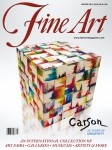
Fine Art Magazine – New York City, USA – Winter 2012/2013 CHARLES CARSON 35 YEARS OF CREATIVITY CARSONISM MOVEMENT “As Hemingway developed a new style of writing that is oft-imitated, never attained, Carson has created a new way of painting that takes a similar heightened position in the mainstream of contemporary art, a form that is universally accessible but impossible to be duplicated by another. A language all his own forever to be known as ‘’Carsonism.’’ “I will not paint if I have nothing to say.” 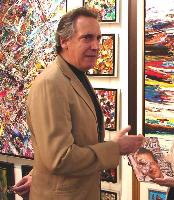 Victor Bennet Forbes, historien et expert en art, éditor en chef du FINE ART magazine, New York, USA By VICTOR FORBES UP AND DOWN THE AVENUES, the buildings in New York City, (considered by many to still be the modern day capital of the art world) are decorated with the work of the world’s best-known artists: Stella, Lichtenstein, Oldenberg, Picasso, Kline, Indiana and de Kooning to name but a few. There are massive paintings and sculptures by these and many other all-time greats housed in lobbies, entrances, boardrooms, parks and offices. Attaining the heights reached by such stalwarts would seem to be the goal of most every artist who sets brush to canvas, chisel to stone or ink to paper. So much art has been created over the centuries that to be merely recognized is an accomplishment; to sustain a life of creativity is a triumph. To be hailed as an all-time great and have your work sell in the millions of dollars while you are still alive—that does happen, even if only to a very select group. There are a myriad of factors that contribute to entering into that realm, no singular formula. Often greatness is in the eye of the beholder, embellished by simple twists of fate, connections and timing. Pure talent, originality and depth of message will only get you so far. Bob Guccione said that it took a great leap of faith to see his artistic dreams come to life. “There was a time,” said a well-known dealer who has placed works in major museums, “when you could succeed just on the quality of the art alone, but today you could be the greatest artist in the world and if you don’t know the right people and have the right friends, you often remain unknown. You have to be a showman and a promoter on a much bigger scale than even in the day of Dali and Warhol, plus you now have to be technically savvy to capture the world market. The world got smaller. You have to be popular everywhere, not just New York, Paris or Spain.” Art is a product now, not just a creation. It needs to be marketed, auctioned and accepted by the mass media. The factors that bring recognition to some and lack of same to others are not simply intangibles any more. Such elements are taught more in business and marketing programs than in art schools. People studying art today are told by their professors to prepare to starve, to find other ways to use their artistic talents so they can earn a living. But if anyone said this to Charles Carson, he certainly wasn’t listening. Entrevue Victor Forbes, Art Expo 2009 – New York – Fine Art Magazine USA (Traduit de l’anglais au français) CREATIVE GENIUS A language all his own forever to be known as “Carsonism.”
The origins of Carson’s style were formulated in the interior of the Catholic churches he visited as a boy. Whether situated in a rich parish or a modest village, the buildings were reflections of baroque tastes dictated by centuries of religious architecture. “It was required,” notes the artist, “that the House of God be the shiniest and most sumptuous of all.”
“As a young child, I attended the religious ceremonies. I observed everything—the “trompe-l’oeil” paintings, the priestly garments embroidered in gold, the gathered crowds. I recall these things to this day with emotion. I was already under their spell when I passed through the heavy church doors. I had a precocious awareness of symbols – dipping my index finger in the fountain made me feel pure and legitimized. For what purpose you may ask? To enter a sumptuous treasure trove. To feast my eyes on everything shiny, the dancing flame of the lanterns, the candelabras. Mingled with the odor of melting wax from the candles, floating in the air, the scent of incense…”
It is these memories that have served as the basis to create a new style — a completely new pictorial language — that makes an appearance on the scale of artistic values in a way that has nothing to do with the current directions, genres or styles that are mostly found in today’s or any day’s art market. Born in Montreal in 1957, Charles Carson has been devoting himself entirely to his art since 1983. Over the years he has participated in numerous exhibitions in Canada, the United States, Europe, Asia and South America. At the age of 33, Charles made his own discovery of Latin America and lived in Columbia for nearly 10 years. Here he produced extraordinary and exotic works, yet he always retained his sensitivity, depth and vivacity, as well as the dynamic range and variety of composition. Yet his paintings still hint at the winters of his youth — those gray storm-clouds that visit his works and give them a striking three-dimensional feel. “Although born in Montreal, I spent many years living in remote country settings where
I pursued my chromatic search before moving to South America. I wanted to live new experiences, artistically as well as culturally. I developed a passion for skin-diving and gained artistic inspiration from scenes on the ocean floor, from the multitude and variety of colors to the cathedral light produced by the sun piercing the ocean surface. One day, I nearly lost my life during a skin-diving expedition. The whirlpool that nearly swept me away did not affect my love for open water.” Be it the roar of an ocean or the flow of a river, the excitement of the potential danger manifested in broad strokes of the pallet knife, in blue sheaves and successive waves, to form the pictorial theme of a marine scene in the Carsonism or mosaic movement.
What creative energy ! “…one must recognize the undeniable talent of Charles Carson for his exceptional sense of chromatic harmony: his blue inspires dreams, his red surprise the eye, his yello illuminates the heart…” “A chromatism that is at once harmonious and audacious, a play of transparencies and depths, dynamic composition and a continually renewed sense on innovation. Here is the winning recipe that propulses the artist from one success to the next.” /2003 Arévik Vardanyan, Advisor in art and museology
In recognition of his contribution, a life-size statue of the artist in bronze has been on view in a major Cartagena public building since 1997. He also created a monumental mural entitled El Caballo del Mar for the main hall of Cartagena’s principal airport, and he executed another mural entitled Yo hice lo que tu querias for the Church in Santo Domingo (a renowned Heritage Monument).
There is one constant in all of the analyses and for each of the experts and art historians and it is this: Carson’s work generates energy, an unparalleled “joie de vivre” which is reflected in a mastery of forms and transparency of colors. His physical control is always evident and he paints in bold strokes of incredibly vibrant color yet with a delicacy and intimacy that touches an emotional chord in the viewer. The making one of the strength and softness is the basis of the resultant beauty. This masterful technique has gained the artist a legion of collectors and admirers internationally and his works are sought after by serious collectors around the world.
Early in his career, the artist employed traditional techniques, gaining inspiration from his environment. His early figurative works left him unsatisfied and he started to lean towards a semi-figurative and extremely personal style of painting. This technique, along with his unique pictorial language rapidly affirmed themselves and his talent was revealed with each new creation. The artist produces extraordinary works that exhibit sensitivity, depth and liveliness, as well as dynamism and variety of composition that characterize his work. “From an early age, I was in search of other sources of inspiration. I was born with a personality that was exuberant, imaginative and inventive. My inherent curiosity instilled in me the desire to delve beyond a simple explanation of how something worked. My persistence helped me to find answers to many questions – not necessarily the best answers or those that were for my own good.
In international art exhibitions, Carson’s work stands alone. His stalls are sanctuaries in which he and the viewers can escape to a tranquil place, inhabited with a realistic presence of the aforementioned storm clouds but marked with a placidity, a bouquet if you will of sweetness and softness. The flowers, the fish and the birds are created with a power reflected the divinity of their creation, represented by an artist who considers it his right to transform a concrete image of the eye into something different guided by his innate sensitivity and an artistic gift that allows him to incorporate into his works personal feelings, to share his universe of color, dreams, thoughts and emotions. Carson says, “The art of painting is to forget the subject matter; it no longer exists, relegated to the shadows, lights and reflections of color.” van Gogh may have said the same thing. They both take the reality of a scene and transform it into their own very specific concoction that somehow, when put together, is a coherent, emotional and brilliant force. Watching Carson at work is like watching a tiger in his natural habitat. Stalking his prey, the artist is firm in his quest. The quest being perfection, that is to make something, lterally out of nothing that has an impact on one’s emotions and beyond that, to get the world to recognize his creations as valuable entities in the continuum of art history. It may be legitimately asked, how many artists are so instantly recognizeable that critics had to come up with a name, i.e. a school of thought even, for the produced work. That Carsonism has caught on is not just a freak show or the work of a great publicist. The fact is he has taken all the schools that have come before him, blended them into his subconscious and developed his art form.
Carson is far from one-dimensional and a follower of no one. He would not exhibit a single painting until he was certain he had created an approach that could only be attributed to him. It came after years of contemplation, hours of experimentation and decades of polishing a format that came to be known as Carsonism. How many artists are so attached to a style that the world recognizes it by the artist’s own name? Was there an artist named Impression? Or Modern? No. Carson created his style, his language and whether it was because he was ostracized in gym class for lack of athletic ability, or because his family didn’t send him to a fine art finishing school, or whatever the reason, Carson put himself in front of that blank canvas, or whatever else he was working on, and made it resonate with his own words. It’s a language we all can understand, no matter the country of our origin and it is a lot easier to communicate internationally in this manner
Carson a discovery … “Carsonism”, 1992 “In my capacity as art expert and historian, it has given me great pleasure to examine a significant quantity of the artist’s paintings. I was struck by their freshness, dynamism and rhythm — the freshness and vivacity of the palette, the dynamism and diversity of the compositions, the rhythm that animates each segment of his paintings, much like the best jazz piece whose sense of improvisation opens up the instinctive structure of the melody and animates it with its syncopated syntax. If one prefers, it can be compared to a Scarlatti sonata or a Vivaldi concerto whose variations and modulations define the structure and subtlety of the piece.” Carson gives his paintings a depth that makes the best demonstrations of perspective pale in comparison… Founder of the Musée d’Art Contemporain de Montréal, art historian, writer and editor, author of an analysis in which “Carsonism” was described in glowing term. “Carson to the ism”.
“Hero of Creativity” – Let the next writer come up with a better catch phrase, for now that is a standard they have to top. What Carson has done is invent an approach to life that is that of a warrior wielding a paintbrush for a sword, A ninja in paint. His mannerisms are disciplined. There is no waste or obfuscation. Everything is crystalline. Shining, bright and brilliant, even in the way he operates the front end of his business, travels to exhibits, sets them up, prepares the wall space of an exposition so that every inch is maximized. He is not going down without a fight and every aspect of his creativity is measured. Hemingway’s sentences are short and sweet. Could he write like Fitzgerald or Faulkner or Steinbeck? Maybe. Pollock could draw. He could render so that when a fool looks at a drip masterpiece and says, “My kid could do that,” well maybe. But he certainly couldn’t knock out a realistic charcoal passable sketch which gave Pollock credibility with the so-called cognoscenti.
It is an artistic and creative fact of life that Carson goes about his work with a precision that is almost unfathomable.
“Richard told the curator that if his banner outside was one inch smaller than Picasso’s, they could forget about the show.
How did you grow into becoming an artist? I did not attend a fine arts school despite my desire to do so. Neither my family nor social environment fostered such pursuits. Regardless, this did not inhibit my perpetual search for a pictorial language. The “still life” paintings that I was working at during this time were academic exercises. The subject matter was of little importance. These studies allowed me to explore space and depth, two elements that would be crucial to my future work. I was also doing g Although this creative technique was received positively, I was not through searching. I continued to perfect my technique for juxtaposing colors, using acrylic to create vivid abstract forms. On a linen canvas, I spread pieces of colored glass, complemented by strokes of acrylic to create an impression of haut-relief. Then, to make the colors explode, I highlighted them with an ultra bright lacquer. I was fascinated and seduced by the art of the master glassmakers of Murano and to emulate their artistry, I heated huge, multi-level ceramic ovens, created moulds and inserted my glazed pieces at a temperature of 2,000 to 3,000 degrees. What kind of artist tools did you employ? I desperately wanted to reproduce with paint, the textures, forms and transparency of stained glass windows. I used oils, acrylics, pastels and charcoals in my artistic process. All recovery areas served to advance my experimentations for adherence and durability. I spared no effort during these years of experimentation with special effects and contemporary art. I would drop bags of paint from the roof of the house and rush to see the splatters they created on the sidewalk! Or I would use a drill to spin a panel I had coated with different colors of acrylic paint. Not to mention the balloon filled with paint that I would burst over a canvas… I even used an old bicycle wheel to spread colors on a canvas to see the effect it produced. Once, I nearly burned my house down experimenting with a special lacquer. This misadventure brings a smile today. I learned that paint and fire do not make good partners. In my efforts to recreate the “Murano effect”, the wooden roof of my studio as well as the work in progress were reduced to ashes. This incident, as is often the case with fortuitous scientific experiments, allowed me to perfect a mixture of glass and epoxy finished with a blowtorch. I lost count of the number of plaster moulds that were sacrificed for the cause. Not to mention the kilos of glass tiles used during the mosaic experiments. Since those days, I have used an acrylic paint that is more malleable for the textures, dries more quickly and allows for multiple layering of color. My first subjects were bouquets of flowers, done in an abstract style. For me, the message necessarily had to be communicated with the proper tools. I strove to find a language that was personal. It was both a quest and a challenge. “Charles Carson’s painting is divided into two approaches which are both distinct and complimentary. One was even named Carsonism by some art critics and historians. This approach is not easy to describe, but generally speaking it is composed of an infinite succession of slightly oblique strokes which, on the surface, add maximum energy to our perception of theme and subject, with the whole being animated through subtle transparencies which are quite sensational, creating an impression of depth and color. It’s like an incessant flow of particles — all the same size — which sweep the paint with fascinating, even disconcerting regularity. Carson’s second approach is simply that of mosaic. As its name suggests, we find a fragmentation of form and surface characteristic of the mosaic style. In both instances the artist endows the surface of his canvasses with great energy, creating an altered state in which his powerfully metaphorical universe is expressed.” Robert Bernier, art historian Magazine Parcours, The Advisor of Arts – Winter 2004 While nowhere nearly as famous or collected as Picasso, at the recent Armory art fair, the Poussette-Dart’s were flying off his gallery’s wall at about $400k for a 30” x 40”. Mid-show, I heard the dealer call Evelyn asking for more.
Whether fighting off the gym class bullies or working his way out of a cylindrical spout of water in which he almost drowned, Carson’s paintings show a power that opts for life. In the Carsonism pieces, he recreates natural scenes with deconstructionist vengeance, the three dimensionality of his minute dollops of sculpted paint surround the spaces, fill the emptiness. That’s Carson to the ism. Clean, well-lit. Fully functional but esoteric. “Oh, there’s a bird amidst all that,” a viewer would note. Or a fish. Or a reflection from light cascading to the depths of the sea or a natural burst of energy from a trip up the Amazon. Carson has been there and done that and the main thing is that he gives these scenes, these segments, these minute conglomerations of acrylic a glazed energy so that when they are combined into one unit you see exactly what he wants you to see. The veil is opened, but the real question is: “to what?” That’s where the art critics come in. They know and they have seen. Carson isn’t saying. It was more than enough for him to invent this style and then to top it off with what he calls the “Mosaic Movement.” This is a whole other field of dreams, but if you could chop off a bunch of square inches on a mosaic and drop it into a canvas of Carsonism, they would work together. Blend somehow in unity. After all, wasn’t it the American poet/philosopher Eli Siegel, founder of Aesthetic Realism, who was famous for his statement, “Beauty is the making one of opposites.”?
As successful as he is, there is a hunger to Carson that seems to be unquenchable. An insatiable thirst to do more, to do better, to be the standard by which all other artists are measured. In this world, there is a train to glory and Carson is a passenger, riding close to the front. John Dunne made this statement for eternity: “No man is an island” and that’s for sure. “It matters not for whom the bell tolls, it tolls for thee.” Carson sees this and his stance as an artist of great individuality is tempered by his compassion for the earth and his fellow man. His paintings are manifestations of his thoughts and deeds, his hopes for a better world, a just world, a beautiful world of peace and harmony. Knowing this about him further fuels our interest in his creative vortex — a whirling mass of sensibility and sensitivity to not only God’s love but our obligation to our Creator to return favors granted. This is the meaning of the creative life in which we strive for greatness, recognition, riches and fame (of course) but in doing so, seek to bring mankind along with us. It’s a long train running, this train for glory, and the sensitive ones are prone to fall by the wayside. Carson tempers his passion with great control, seemingly, in his work and this may just be the key to unlocking the magic in his imagery and in his reason for being. Getting his message out to as many as possible is a motivating force in his life at this time and recognition from the media and an ever-growing group of collectors fuels this. Carson is building a legend and could that be said about you and me? And if not, why not? If Carson could do this, why can’t any of us? and that seems to be what he is telling us in a language we can understand: the language of creativity. We are all born with certain gifts and it is up to us to discover and exploit them. Carson’s placid demeanor houses a fury inside which must come to the forefront. Fortunately for him, and us, it does. Whether he will go down in the annals as the great master many think he is, time will tell. One thinks that if a Carson is placed side by side with any contemporary or even historic work of art, the Carson will rise to the top, in much the same way that musicians can be compared, or ballplayers or even journalists. What it all comes down to in the end is how deeply we are committed to developing and perfecting the kernel of greatness that resides inside us all. How often we miss the mark and come up short, whether in art or life, and how often must we push ourselves, pick ourselves up dust ourselves off and start all over again? As often as it takes, say the great ones. Therefore in this period of time, it is a great to be alive while Charles Carson walks the earth and paints his paintings. Strong and calm, he leads us on a straight and narrow path to our pre-ordained destiny. After all, we weren’t born here to be mediocre, were we? The pursuit of greatness is open to all. The force of real love is the fuel, combined with talent innate, that gets us where we have to go, less we fall by the wayside and have to come back and do it again.
“Charles Carson presents us with magnificent visual richness. The viewer must learn to read – consciously or not – the scenes or subjects being proposed. Carson interprets and transposes with great strength and subtlety. An attitude that within the visual arts world, precedes and follows all major careers.” – 1993 Jacques de Roussan, (1929-1995) Historian, publisher, writer and art consultant.
In my younger years, I was fascinated by sunligh-t shining through stained glass windows. This image has always had a hold of my imagination which probably explains why I have always sought to replicate this transparency and luminosity and to create the effect of light coming from behind the canvas. Both the Carsonism and mosaic movements are reflections of water in motion.” — Charles Carson “To be able to know such an artist during his lifetime is extremely rewarding.” By CHRISTIAN SORRIANO, Paris 2009 Art no longer holds any secrets or mysteries for a seasoned pro like me. Copyists, imitators and opportunists are quickly unmasked; self-proclaimed “artists” daubing in images of the sea, flowers, bodies or faces that have no soul, no emotion. Shunning popular trends and cheap visual effects, Charles Carson reveals the many unique facets of his immense poetic skill in each and every one of his paintings. They offer a breath of life, his life, questioning and delighting the minds and trained eyes of connoisseurs. Charles Carson has staked his claim to artistic posterity, for today one proclaims “it’s a Carson” in the same manner that one refers to the works of immortal artists like Picasso, Matisse, Warhol or Basquiat. Christian SORRIANO, President of Drouot Cotation, Expert in Arts and Antiquities, Expert in public auctions, Expert and assessor with the Customs Commission, Expert for Administrative Tribunals, Expert with the International Union, Official government representative, by ministerial decree dated December 2, 1992, with a mandate to organize the “Art and Antiquities Professions”
“Charles Carson has the art of deconstructing his designs with an astonishing elegance. The purity and transparency of colors and their juxtaposition bring them all into a harmonious whole stemming from and inspired by the pleasure of handling forms. These enigmatic compositions, transformed in the laboratory of his fertile imagination clearly show the mastery of the artist.” — LOUIS BRUENS, Art historian, writer and expert, Founder of Académie internationale des Beaux-Arts du Québec
When Carson meets his maker, it is certain he will be told, “Well done…You have been faithful over a little; I shall set you over much; enter the joy of your Lord.” Carson says he has learned much in his 55 years on this earth. I have learned much simply by observing him, his actions, his work ethic and the response to it. While I have many objects of art in my environment, the Carson stands out as a champion. Not for its size, but for its power. It is a conglomeration of everything the man represents: legitimacy, attention to detail, the yin of softness and the yang of accountability. A light emanates from it. Herein lies the secret to human happiness: get it done and get it done right. There’s a serenity, as if feng shu-ing life from the inside out. Carson makes a case that we can have it all. Teaching by example deep wisdom, Carson’s paintings simplify dichotomies, pinpointing pathways to understanding, what the yogis call self-realization. Hendrix said, “Love can be found anywhere, even in a guitar.” Carson seems to be saying it can be found in a simple brushstroke, a collection of which brings thought to life, a triumph of good over evil. Of mind over matter. Of gain over loss. Thankfully, we have on earth, in our midst, in these pages, a representative of the power of a still, small voice speaking to us amidst the storm. With an artist like Carson at work, it is indeed a good time to be alive, if for no other reason than to see what will be his next creative invention. Victor Forbes is Editor-in-Chief and co-founder of Fine Art Magazine, published continuously from New York since 1975
I am responsible for laboratory analyses and expertise in archeology and works of art, better known as the Laboratoire LAE. Our job is to authenticate works of art, that is, to make a scientific study of a work of art. We analyze the material that defines the essence of an artist in order to thwart forgeries. We analyze the composition of the constituent materials of a work of art in order to discover the gestures, the experience, and the creativity of the artist. I believe that our work is very rewarding and that it’s an opportunity because we get to meet great creators, great artists and beautiful works, which can sometimes be of very humble origin. This is the case, for example, of the first drawings in a decorated cave or the primitive writings of an ancient manuscript. But this can also be a brush stroke of a Leonardo da Vinci or the touch of a van Gogh, a Matisse, a Monet or a Chagall. So many great creators, great artists, who in their own way, help shape our evolution and humanity. I like to say, quite simply, that the works of these great masters are also important and bring as much information as the equations of Albert Einstein. So, you ask me, through all this, where does the work of Charles Carson stand? Well again, we are very fortunate. To be able to know such an artist during his lifetime is extremely rewarding, because we know for a fact that his work will shape our evolution and humanity. Charles Carson is a great creator. His work is inimitable, personal, spontaneous. I don’t know of any other work that resembles his. It is halfway between abstract and figurative art, it is not part of any movement or trend. His work is a superposition of materials, of shapes, colors, drawings that create a world of its own that is visually very rich, so rich that it even creates a world of sound. To be copied is the fate of great artists and Charles Carson will not escape this. His work is extremely unique, and we know from experience that it is very complex to copy his work, but it is also what defines the quality of a great artist, in this case a great Canadian artist. – BÉATRICE SZEPERTYSKI (Director and Founder of the Laboratoire d’analyses et d’expertises en archéologie et oeuvres d’art, a laboratory for analyzing archaeology and works of art that is better known as the Laboratoire LAE, Bordeaux, France. Scientific expert in art, Expert in the central office against the trafficking of cultural property)
“I deeply wanted to develop an original method of painting because I find it trite to simply paint what the eye sees. This led to attempts to dematerialize landscapes into more abstract and figurative forms. I am flattered that many … have analyzed my pictorial language and commented on its uniqueness and originality.” – CHARLES CARSON Charles Carson: A Master For Today Over 37 years of publishing an art and cultural magazine, we have had the privilege of meeting so many gifted people over this long a period of time. Can you imagine what it would be like if people didn’t have art? It would be a terrible plight. It’s a great honor to be involved with people in the arts. Some artists have risen to great acclaim and importance while others fall by the wayside, but the intrinsic stories of the artists are pretty much the same. Each brings his or her own need to communicate to the viewer through a window they open to their soul to express something deeply personal to the next level. I saw that the paintings of Charles Carson have a unique language. Initially, it was difficult to discern what the abstracts were telling me. Now I understand them very well. The language of the more Impressionistic pieces — the dreamscapes — I felt was very unique with the color usage and balance. The florals and seascapes invite you into the space to taste the colors. You are part of the process of whatever this moment is that the artist is describing. You are welcomed into the imagination of the process, which is far deeper than a mere snapshot. Here you will find the inspiration and mystique involving the colors combined with the rendering of the line: defined and united, yet singular in their presence, made all the more powerful by their coalescence and shared space which not only enrich the composition, but enable the viewer to comprehend the essence of the artists’ vision. The application and creation of the form is married to the colors so that the composition becomes very free, very available for people to enter into. The quality, the union — the synergy — brings success as the artistic statement is there and quite inspiring. Researching, reflecting and understanding, I could see that Charles has a great drive, capacity and great enthusiasm for the art. The level of his painterly energy carries the artistic statement through, bringing it to life and making it readily understandable. His colors serve the message even as the message serves the color. Carson, through his unique approach and visual language, lets people know immediately through the finished product what is that piece of the dream, that metaphor he is describing — his alphabet, as it were. When you do this successfully, you instantly have the viewer, if not you lose them. My initial foray into writing about Carson’s art was like a food for me. Describing Carson’s experience and offering it to people to enjoy was and continues to be, incredibly satisfying. Energetically, when viewing his work, Kandinsky, Mondrian, Picasso and van Gogh come to mind. Although one could say that there are those influences, Carson has a great respect for any artistic process that is authentic, that it is important to avoid ephemeral fashions and trends. Why Carson? He has a tempo. You can’t just paint and extrapolate unless you know form. You have to be able to paint in order to extrapolate as if the light is coming through so he applies the paint with a structure and energy that results in an almost kinetic activity in a stationery work of art. The form that results through this enhanced application of color is obviously from his subconscious yet well-studied intent. His vision allows him to step between the spaces and resultant colors not only emerge, but they vibrate. As one form transitions from dream to reality and reality to dream and the abstract in-between, Carson manages to keep the transparency and the colors incredibly clean, which is rare. They are built, they have definition and there is a certain texture to the resultant paintings that is complex to arrive at. This combination of harmony and tempo is very complex and difficult to arrive at yet, via his painterly process, Carsonism emerges and it is unlike any other school of thought to date. He set out to be singular, to use the standard materials as no one before him has and he has succeeded. There are elements of this work that I have not seen elsewhere nor have I seen this technique done elsewhere. He is the only one in the world doing this style. Founding a process, a language and an artistic technique all his own, Carson is well on his way to taking his place among the great artists of the era. Source: Fine Art Magazine, New York, Winter 2012/2013 Publication: http://issuu.com/carsonisme/docs/fine_art_magazine_featuring_master_carson DOCUMENTAIRE SUR L’ARTISTE: http://youtu.be/ZkoFf2S8gHg |
.
PARIS 2013 – Le peintre des couleurs a trouvé son refuge.

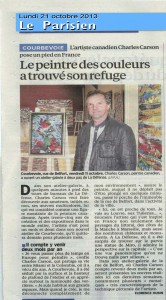
Journal Le Parisien 21-10-2013 L’artiste canadien Charles Carson pose un pied en France. Le peintre des Couleurs à trouvé son refuge.
ATELIER CARSON – GALERIE D’ART CONTEMPORAIN DOUKHAN
JOURNAL LE PARISIEN – Plus d’un million de lecteur – 21 Octobre 2013
Le peintre des couleurs a trouvé son refuge
Florence HUBIN
L’artiste canadien Charles Carson pose un pied en France. Courbevoie, rue de Belfort, vendredi 11 octobre. Charles Carson, peintre canadien, a ouvert un atelier-galerie à deux pas de la Défense.
Dans son atelier-galerie, à quelques minutes à pied des tours de bureaux de La Défense. Charles Carson veut faire découvrir aux amateurs, initiés ou non, ses oeuvres multicolores, lui qui est considéré comme une figure montante de la peinture canadienne. Après trente-cinq ans de création et des expositions dans le monde entier, l’artiste s’est posé un mois et demi dans son nouvel atelier de Courbevoie, qu’il quittera demain pour plusieurs mois.
Il compte y venir deux mois par an
«Je veux passer plus de temps en Europe pour peindre», confie Charles Carson, qui partage sa vie entre Miami le Canada et la Colombie, où il a vécu dix ans. A Courbevoie, il a été séduit par la surface et la hauteur de plafond de l’atelier et en apprécie surtout la luminosité des verrière. «Je suis habitué aux grands espaces. Mais quand je crée, je me déconnecte complètement de mon environnement», assure le peintre, auquel il ne déplaît pas d’être plongé en quelques minutes, passé le porche de l’immeuble de la rue de Belfort, dans l’activité de la ville.
«Ici, on est proche de tout. Je vais au Louvre, aux Tuileries …». énumère l’artiste qui s’est inspiré en France non seulement des paysages du littoral, des côtes de la Manche à Marseille, mais aussi des nombreux châteaux et monuments. A La Défense, où il a été surpris de trouver sur le parvis une statue de Miro, il admire la perspective sur la capitale : « C’est une vue panoramique qu’on ne trouve nulle part ailleurs. »
Dans son atelier-galerie de la rue de Belfort, où Charles Carson compte revenir deux mois par an, seront présentées les oeuvres réalisées ici ces dernières semaines, notamment plusieurs «mosaïque» très caractéristiques de la technique picturale de l’artiste.
ATELIER CARSON – GALERIE D’ART CONTEMPORAIN DOUKHAN
INFO : MME FABIENNE DOUKHAN
53, RUE DE BELFORT – 92400 COURBEVOIE, RÉGION PARISIENNE
(A deux pas de la Défense)
Pour Rendez-vous :
Bureau: 01.43.33.52.63 -Portable : 06.09.47.43.60
________________________________________________________________________________________
GALA DES SOMMELIERS DE PARIS 2013
Soirée de prestige en ce dimanche 13 octobre 2013 organisée par l’Association des Sommeliers Paris au « Four Seasons Hotel » George V, Paris. Une soirée qui se renouvelle chaque année et qui est un des plus beaux rendez-vous du monde du vin et de la sommellerie. Cette soirée était empreinte d’un esprit particulier puisque Monsieur l’Ambassadeur de l’Amérique du Sud ainsi que Monsieur Charles Carson, Maître en beaux-arts du Canada, ont honoré de leur présence la soirée de Gala.
Les grands noms du vin et du champagne étaient présents, les vins furent dans leur majorité grandioses, le grand chef Eric Briffard, meilleur Ouvrier de France a réussi l’exploit de servir un repas impeccable sinon magnifique pour plus de 400 personnes sans une fausse note. Une ambiance amicale, joyeuse et conviviale, un bon esprit, des personnes de talent motivées pour défendre le bon et le beau et une soirée où tous les bénéfices de la grande vente aux enchères iront aux Secours Populaire Français.
L’Association des Sommeliers de Paris
Remercient les Invités d’honneur
*****
Ambassadeur de L’Afrique du Sud
Charles Carson, Maître en Beaux-Arts, Québec, Canada
Discours de Charles Carson, invité d’honneur au gala annuel de la sommellerie de Paris, tenu à l’Assemblée nationale en ce 13 ieme de septembre 2013.
« Bonsoir à toutes et à tous,
Je tiens à remercier tout d’abord Monsieur Philippe Pares, maître d’hôtel et sommelier à l’Assemblée nationale, qui a eu l’amabilité de me convier à cet évènement prestigieux, me permettant ainsi d’y apporter ma collaboration. Je tiens tout particulièrement à m’associer à votre gala annuel de la sommellerie de Paris et à vos invités de marque.
Mes 35 années de créativité m’ont permis de créer une forme d’écriture picturale nouvelle – Mouvement intitulé par de nombreux historiens de l’art : Le CARSONISME.
Je ne veux pas vous prendre un temps précieux pour le définir. De nombreux textes ont déjà été rédigés sur le sujet par des spécialistes, experts et historiens de l’art. Ils reprennent et commentent les éléments essentiels de mon œuvre : «Le Mouvement Carsonisme» que je vous invite d’ailleurs à consulter sur le Web.
Pour créer, disait MOZART, « Il faut rester dans l’idée ». Je crois que le visiteur en s’arrêtant quelques instants devant une de mes œuvres aura pu déceler que l’idée principale est issue de l’esprit, qui est née d’une pensée, d’une émotion.
Les sujets d’interprétation de mon art sont multiples et originaux et ils ont tous des points en commun, la transparence et la juxtaposition limpide des couleurs. Mes œuvres traduisent une histoire, une émotion particulière qui me touche et elle m’est ensuite révélée par ma spatule ou mon pinceau…
Une *giclée-graphie à haut relief d’une de mes créations, en édition limitée de 35 exemplaires, intitulée le Parc Tairona, sera mise en vente aux enchères.
Je terminerai … par ces paroles :
« Qui dit humanité … dit liberté, la liberté d’être bon avec les autres. La liberté d’être heureux et de pouvoir vivre dans la dignité, un droit essentiel pour tous les enfants du monde. »
Je vous remercie du fond du cœur de votre présence, je lève mon verre a votre santé aux amis (es), ainsi qu’a tous c’elle et ceux qui mon accompagné et qui m’accompagne dans ma démarche artistique.
je vous souhaite une excellente soirée. »
*Adjugée à 5 000 Euros, cette Giclée-graphie à haut relief, intitulé « Parc Tairona », a été adjugée à Monsieur Pierre-Emmanuel Taittinger, président du Champagne TAITTINGER. Les fonds iront aux Secours Populaire Français..
Les Partenaires « Champagnes »
AYALA, BILLECART-SALMON, BOLLINGER, CHARLES-HEIDSIECK, DEUTZ, DELAMOTTE, DUVAL-LEROY, KRUG, LANSON, LAURENT-PERRIER, MOET-CHANDON, MUMM, PERRIER-JOUET, POL-ROGER, POMMERY, PHILIPPONNAT, RUINART, ROEDERER, TAITTINGER, VEUVE CLICQUOT.
Les Partenaires « Privilégiés »
CHATEAU PEYRAT-FOURTHON, EFFITIC, FORCE IV, GUY VIALIS CREATION, LES ELEVES DU CORDON BLEU, LA VINICOLE FRANCAISE, NESTLE-WATERS, SOBOVI, UNION DES GRANDS CRUS DE BORDEAUX, ET LA VERRERIE RIEDEL.
Les Partenaires du dîner
CHAMPAGNE TAITTINGER, HERMITAGE DOMAINE J.L CHAVE, MADEIRA SERCIAL D’OLIVEIRAS, SAINT-EMILION CHATEAU FIGEAC, SAINT-EMILION CHATEAU CHEVAL BLANC, SANCERRE DOMAINE F. COTAT, VIN DE CONSTANCE KLEIN CONSTANTIA, PORT QUINTA DO NOVAL, CALVADOS CAMUS, PERRIER, SAN PELLEGRINO, VITTEL.
Photographe : Grégory Pigot
ALBUM PHOTOS: https://plus.google.com/photos/105127049225527268058/albums/5934955985238230465?banner=pwa&authkey=CP3q–bqyMuXrAE
______________________________________________________________________________________
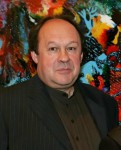 Journal, LA PRESSE
Journal, LA PRESSE
Premier quotidien de la France Libérée
A la rencontre de Charles CARSON et du carsonisme.
Louis Lefèvre, journaliste et critique d’art
«Le Canada est une véritable pépinière de talents artistiques. Lorsque l’on évoque nos cousins d’outre Atlantique ou du Québec, on pense aux Garou, Céline Dion, Gilles Vigneault. Autant de noms qui évoquent autant de chansons à succès. Cependant le monde de la culture canadienne ne se résume pas à la musique. L’art c’est aussi la peinture. Et dans ce domaine, il en est un qui n’a rien à envier à tous ces chanteurs, car son talent est au diapason : le peintre Charles Carson.
Chez Charles Carson, sa partition à lui c’est une palette toute en nuances. Ses notes, il les joue et les chante avec ses pinceaux, dans un formidable feu d’artifice de couleurs toutes plus éclatantes les unes que les autres. Cela donne des tableaux qui ne laissent personne indifférent. Sans aucun doute c’est ce que l’on appelle le talent. Son œuvre, si elle n’est pas encore connue chez nous autant qu’elle le mérite, est déjà reconnue partout ailleurs. Au point que cette œuvre n’appartient plus tout a fait à l’artiste. En rejoignant dans la notoriété celle des plus grands peintres d’hier, elle entre dans le patrimoine universel d’aujourd’hui. Et prépare celui de demain.»
«Les toiles de Charles Carson attirent indéniablement le regard. Mais attention, ce ne sont surtout pas les œuvres d’un seul regard. Toutes autant qu’elles sont, ces toiles méritent, un deuxième, un troisième… un énième regard. Approfondie de préférence.
Et là, on va de découverte en découverte. La première impression qui emmène le plus souvent le profane à voir dans toute cette peinture de l’abstraction et encore de l’abstraction s’évanouit peu à peu. La dématérialisation de la nature qui a servi de moyen d’expression à l’artiste recompose peu à peu le sujet.
Au milieu de toutes ces couleurs qui éclatent dans chaque tableau apparaît alors une multitude de sujets qui font la richesse et la force de l’œuvre. C’est pour le spectateur un nouvel éclairage qui se fait jour.
C’est pour lui le début d’une communion avec ce que le critique d’art et fondateur du musée d’art moderne de Montréal Guy Robert a appelé le Carsonisme. Une nouvelle écriture picturale. Une écriture qui va chercher dans le dictionnaire de la nature son inspiration pour en faire une fête permanente du beau et de la couleur.
A force de recherche et de travail, après 30 ans devant ses chevalets, avec l’inspiration et l’obstination pour seuls témoins, Charles Carson a bâti une œuvre unique en son genre. Une œuvre forte et belle.
Avec un style ô combien maîtrisé qui n’appartient qu’à l’artiste. Pour aboutir à une peinture différente. Une peinture éclatante de force et de luminosité.
L’oeuvre d’un génie qu’il ne faut pas avoir peur d’installer dans le cercle très fermé des grands, très grands artistes, qui marquent de manière indélébile leur passage dans le monde de l’art et des arts. »
Les mouvements artistiques nés au Québec
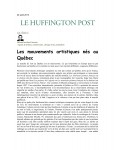
22 août 2013
Agente d’artistes, commissaire, critique d’art, journaliste
Les mouvements artistiques nés au Québec
Le marché de l’art au Québec est un microcosme. Ce qui fonctionne en Europe peut ne pas fonctionner au Québec et le contraire est tout aussi vrai: marchés différents, exigences différentes.
Bien qu’on parle plus facilement des courants artistiques européens qui ont cours depuis la crise de l’art, les mouvements se terminant en « isme » existent aussi de ce côté-ci de l’océan Atlantique. Certains ont été créés par des Québécois d’origine et/ou des Québécois d’adoption. Ils ne sont ni laids, ni angoissants, ni violents. Pourtant la presse n’en parle pratiquement jamais parce que les journalistes spécialisés dans les arts visuels sont rares et, sans doute, le lectorat préfère s’adonner à une lecture plus sensationnelle que culturelle. Selon la sociologue de l’art très connue, Raymonde Moulin, 5% seulement des gens s’intéressent aux beaux-arts. D’ailleurs, la légende urbaine qui prétend que les galeries d’art sont fréquentées par des snobs et que la peinture est destinée à une élite sociale subsiste toujours dans l’esprit des gens. Bien sûr, ce mythe est aussi faux que l’image des vernissages qu’on nous présente dans les films américains. Le monde de l’art est loin d’être aussi guindé qu’on nous le présente à l’écran. La caricature de la réalité fait ombrage aux artistes qui essaient de vivre de leur art dans une société axée sur la productivité, la rentabilité et la réussite sociale. Il faut donc redécouvrir cette réalité toute simple… une réalité qui, aujourd’hui, met à l’honneur des artistes québécois qui se démarquent en étant instigateurs et instigatrices d’un mouvement artistique au Québec.Plusieurs mouvements artistiques européens ne sont pas connus au Québec alors qu’en France, par exemple, la tendance néo-expressionniste apporte aux artistes qui pratiquent ce mouvement son lot de succès dans les hautes sphères du marché mondial. Les nouveaux peintres français de la douleur ont été connus, notamment grâce à une monographie de l’essayiste belge Guy Denis qui publia son livre (Les peintres de l’agonie ou Les nouveaux peintres français de la douleur) en 2008 chez Bernard Gilson Éditeur. Une centaine d’officiels pratiquent ce mouvement en Europe depuis 1997. Une exposition internationale, présentée à Québec en 2010, a présenté des œuvres de l’un d’entre eux. L’incompréhension et la méconnaissance de ce mouvement artistique ont empêché les médias d’en parler. Il a fallu cacher les œuvres pour éviter l’embarras des visiteurs qui entraient, alors qu’en d’autres circonstances, elles auraient été à l’honneur. C’était esthétiquement incorrect de présenter ce genre-là dans une maison de la culture. Récidive dans une galerie d’art en 2011; le laid, l’angoisse et la violence n’ont pas leur place dans le marché québécois.
Certains de ces artistes ont rencontré le succès, d’autres créent dans l’antichambre de la notoriété, rêvant un jour d’être mentionnés parmi les grands qui ont fait l’histoire de l’art au Québec. Je vous propose une série d’articles sur ces mouvements artistiques nés au Québec.
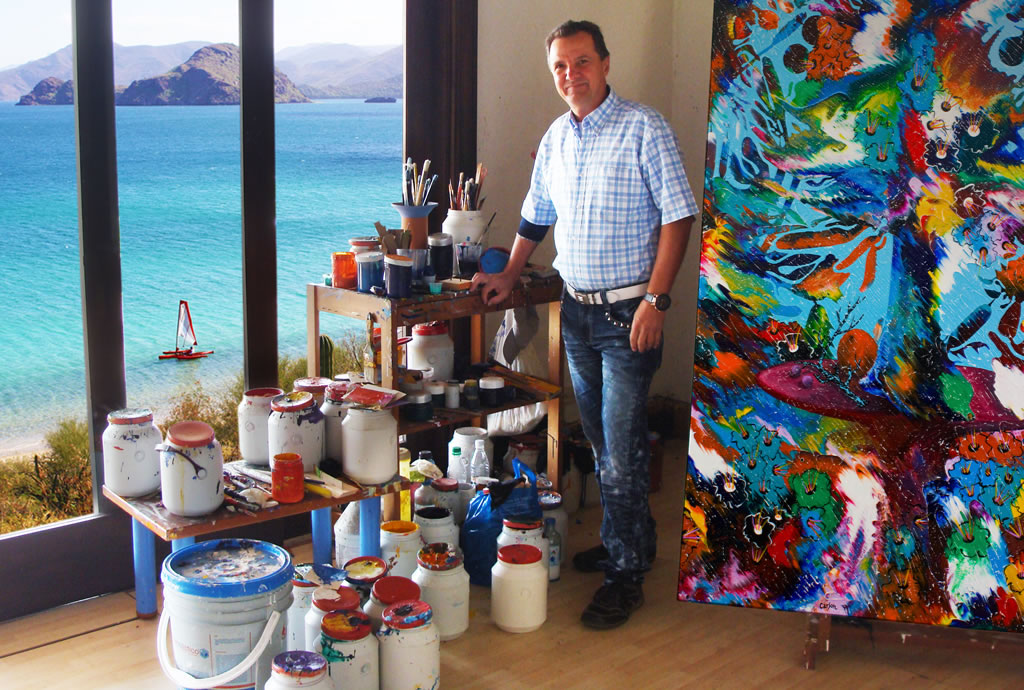
Le Carsonisme
« Charles Carson a creusé son sillon vers la postérité artistique, car aujourd’hui on dit c’est un Carson, comme on dit c’est un Picasso, un Matisse, un Warhol, un Basquiat et tous les autres artistes immortels ». – Christian Sorriano, président de Drouot cotation à Paris, expert en art et en antiquités.
Le Carsonisme est né au début des années 1990, alors que l’historien et expert en art, Louis Bruens, écrivait sur l’œuvre de Charles Carson. C’est par la suite que Guy Robert, le père fondateur du Musée d’art contemporain de Montréal, lui consacra une importante analyse. Il soulevait notamment l’originalité toute particulière du travail de Charles Carson avec les couleurs, avec le rythme et le dynamisme intrinsèque. Il éprouvait une réelle fascination pour cette profondeur qui animait les œuvres de cet artiste. En un mot, le Carsonisme lui faisait l’effet d’une bouffée de fraîcheur dans la morosité ambiante du marché de l’art de l’époque aux prises avec ses préoccupations esthétiques. La vivacité de la palette de l’artiste, sa façon d’occuper l’espace dans une composition rythmée, sa subtilité entre figuration et abstraction, auguraient un futur des plus prometteurs. Ils ont été nombreux, par la suite, historiens, experts, critiques, écrivains en art, à se pencher sur l’étude des œuvres de Charles Carson.
Contrairement à ce que l’on pourrait croire, le Carsonisme se distingue des œuvres de Riopelle. La recherche de Charles Carson est axée sur la juxtaposition et la superposition des couleurs qu’il peint avec grande spontanéité, sans idée de départ, mû par l’instinct créateur, inspiré par le bonheur de jouer avec les formes et les couleurs. Il utilise le couteau à peindre et les pigments d’acrylique. Les formes naissent et l’interprétation se précise. Le regard explore la matière. L’imaginaire fait son œuvre et la toile devient un lieu de rencontre et d’échange. La figuration et l’abstraction se répondent, comme un écho. La vaine querelle entre figuration et abstraction se réconcilie. De nouvelles associations se créent. Les couleurs glissent l’une sur l’autre sans se figer. Arabesques et élans ne sont pas une accumulation désordonnée, ils sont plutôt ordonnés dans un rythme qui peut rappeler celui d’un ballet ou d’une mouvance gracieuse, impressionnant la rétine de formes, de silhouettes et de couleurs vives. L’aspect chromatique des couleurs apporte une profondeur qui éveille les sens. L’expérience de l’art est un langage intérieur, propre à chacun : on aime ou on n’aime pas. L’artiste propose sa propre réalité dans son propre langage. D’ailleurs, sa signature artistique est reconnaissable du premier coup d’œil et gare à ceux qui tenteraient de le copier, ils resteront dans l’ombre de ce « Grand-maître en Beaux-Arts ». Ce « isme » (le Carsonisme) a la particularité de ne concerner qu’un seul individu : Charles Carson, né à Montréal en 1957.
L’artiste qui vit à Montréal est reconnu au niveau international. Il jouit d’une réputation mondiale exceptionnelle. Il n’a jamais cherché à révolutionner le monde de l’art. Il s’y est dédié entièrement et la reconnaissance est arrivée.
.
.
.
.
Attention aux imitations, Stéphanie Rivet – Éric Dupont – Patrick Pépin – Galerie d’art Beauchamp – Le Luxart – Bel Art Gallery – Galerry Rufus – Galerie d’art Emeraude – Beauchamp Art Gallery – Galerie Courtemanche – Latitude Art Gallery – Whistler Village Art Stephanie Rivet – Eric Dupont – Gallery – Les Galeries d’art Beauchamp – Hazelton Fine Art Galleries – Galerie d’art Ambiance – Chantal Malet – Galerie d’art Céleste.
DICTIONNAIRE DROUOT COTATION – PARIS 2013
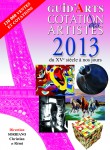
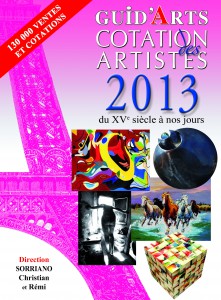
DICTIONNAIRE DROUOT COTATION 2013
En couverture « Sculpture cube mosaïque » du maître en beaux-arts Charles Carson
DICTIONNAIRE DROUOT COTATION – PARIS, 2013
Guide Art Cotation des Artistes du XV IIème siècle à nos jours
130 000 VENTES ET COTATIONS
En couverture « sculpture cube mosaïque » du maître en beaux-arts Charles Carson
Le Dictionnaire DROUOT COTATION Larousse publie plus de 130 000 ventes de tableaux, dessins, gravures, sculptures, photos et arts du feu, du XVe siècle à nos jours. Réalisé sous la direction de *Christian SORRIANO-président de DROUOT COTATION à Paris, association d’experts et de commissaires-priseurs, cet ouvrage est accessible à tous les publics pour estimer, acheter ou vendre des œuvres.
Rédigée sous la responsabilité de commissaires-priseurs et d’experts, le Dictionnaire de Cotation renouvelé et réactualisé offre un large panorama du marché de l’art d’aujourd’hui, et reflète fidèlement toutes les œuvres significatives qui se vendent et s’achètent dans le monde. La reproduction de 10 300 œuvres fait de ce Dictionnaire la plus grande galerie d’art jamais publiée.
Il est proposé à tous ceux qui veulent estimer, acheter ou vendre des œuvres d’art dans tous les domaines de la création. Il est aussi le premier ouvrage, dans l’histoire de l’art, à donner la cotation des artistes contemporains. Le Dictionnaire couvre l’ensemble du marché de l’art.
Cette édition, réunit l’ensemble de ce qui constitue l’actualité mondiale du marché de l’art. Le Dictionnaire Cotation est une référence indispensable pour les professionnels, les collectionneurs et les amateurs d’art qui souhaitent connaître la valeur des œuvres d’un artiste.
 CARSON Charles 1957
CARSON Charles 1957| 38 500 € | La vuelta | acrylique | 91x122cm | 2011 | |
| 45 000 € | Le hibou | acrylique | 122x122cm | 2011 | |
| 22 500 € | Bouquet fleurs | acrylique | 51x41cm | 2012 | |
| 95 000 € | Chant d’oiseaux | acrylique | 152x102cm | 2012 | |
| 23 500 € | Chant printanier | acrylique | 76x76cm | 2011 | |
| 58 000 € | Découverte | acrylique | 152x61cm | 2012 | |
| 33 500 € | Été en éveil | acrylique | 122x122cm | 2011 | |
| 35 000 € | Évasion | acrylique | 76x76cm | 2012 | |
| 92 000 € | Evasion | acrylique | 122x244cm | 2011 | |
| 35 000 € | Finesse | acrylique | 152x101cm | 2011 | |
| 40 000 € | Fleurs sauvages | acrylique | 152x122cm | 2011 | |
| 180 000 € | Fond marin | acrylique | 122x244cm | 2012 | |
| 82 000 € | La croisée … | acrylique | 137x305cm | 2011 | |
| 13 500 € | Le grand chêne | acrylique | 51x41cm | 2011 | |
| 175 000 € | Soleil automnal | acrylique | 247x369cm | 2011 |
.
11 février 2009
Christian SORRIANO
Président de DROUOT COTATION à Paris
Expert en Art et en Antiquités
Pour un vieil expert comme moi, il n’y a ni secret ni mystère, en art, les copistes, les imitateurs et les opportunistes sont vite démasqués. Tous ces barbouilleurs peignant sans âme, sans émotions et sans frissons, des champs, des fleurs, la mer, des corps ou des visages, et qui s’improvisent du jour au lendemain « artiste » !
A l’écart des modes et de la facilité, Charles Carson décline toutes les facettes uniques de son immense talent poétique, en offrant dans chacune de ses œuvres, un souffle de vie, sa vie, afin qu’elles interrogent et réjouissent l’œil et l’esprit des connaisseurs qui les accrochent sur les murs de leur quotidien.
Charles Carson a creusé son sillon vers la postérité artistique, car aujourd’hui on dit c’est un Carson, comme on dit c’est un Picasso, un Matisse, un Warhol, un Basquiat et tous les autres artistes immortel
*Christian SORRIANO – Président de Drouot Cotation, PARIS – Expert en Art et en Antiquités – Expert en ventes publiques depuis 1979 – Expert et Assesseur à la Commission des Douanes depuis 1994 – Expert près de Tribunaux Administratifs – Expert à l’Union Internationale (1992) Chargé de Mission par le Gouvernement français Arrêté du 2 décembre 1992, afin de structurer « Les professions de l’Art et des Antiquités »
« L’héritage d’un artiste révolutionnaire – 35 ans de créativité »
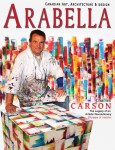
|
ARABELLA magazine, Canada, USA, édition, 2013 Un Jewel Brilliant » Debra Usher «L’artiste canadien Charles Carson est reconnu sur la scène artistique internationale comme le père du « Carsonisme »- un terme désignant ses créations singulières et profonde, pleine de couleur et de vivacité. Il a passé les 35 dernières années à peindre des toiles à couper le souffle, des images qui donnent à réfléchir, alimentée par une passion pour les régions tropicales de l’Amérique latine, lâ où il vécu près de 10 ans et a beaucoup voyagé. Son langage pictural unique rend son œuvre très prisé à collectionner. Son nouveau défi pour les trois prochaines années – la création de murales et de pièces majeure de musée pour les marchés de l’Europe et du Moyen Orient. » « Presque dès le début, il était entendu que Charles Carson serait un succès …. » « …Ses coups de pinceau sur la toile s’apparentent à la flambée des notes trouvées dans les meilleurs solos de saxophone alto. Peut-on oser dire David Sanborn et John Coltrane sont dans le même souffle que Charles Carson? L’histoire décidera, mais en son temps Carson donne une pointe vibrante pour le mystère incomparable et unique de la vie – qui se reflète dans ses oeuvres. » «… Charles Carson a adopté son propre mode d’expression avec la passion d’un maître, mais il possède aussi le nerf d’un aventurier et l’intelligence d’un historien …» «…Aujourd’hui, Carson a acquis une reconnaissance au niveau international et reconnus par de nombreux historiens et experts en arts pour son style unique « Carsonisme ». «…Il est tout simplement impossible d’ignorer un artiste qui a découvert de nouvelles valeurs de l’art, manière qui remet en cause toutes les tendances, des genres ou styles qui dominent le marché de l’art traditionnelle contemporain d’aujourd’hui. Charles Carson à la capacité d’imaginer, interpréter et transposer sa vision unique du monde autour de lui avec force et subtilité. « Il est considéré par la critique comme l’un des plus grands artistes contemporains de ce siècle, Maître Carson ayant saisie le langage picturale parlé autrefois par Mondrian, Riopelle, Jackson Pollock, Sam Francis et Wassily Kandinsky, l’artiste a su prendre les devants – Car la création et la mise à jour de son mouvement tout à fait unique et original, interprété d’une tel façon théâtral et magistral, qu’aucun de ces grands maître ou génies de l’art des temps passé, n’avais su imaginé ou même pensé jusqu’à présent. » « Ces figures légendaires ont accompli des exploits extraordinaires, mais aucun n’a créé d’une manière si unique, si personnel son style, qu’il ne pouvait-être définie par un isme. Carson, par son unicité inégalé, un nouveau mouvement est né. Le « Carsonisme ». Source : ARABELLA magazine, Canada, USA, édition, 2013
Magazine ARABELLA, Winter, 2012/2013 The Legacy of an Artistic Revolutionary Charles CARSON, mba Artist to Collect / 35 Years of Creation A Brilliant Jewel written by Debra Usher The term “Carsonism” reflects Carson’s All consuming devotion to original painting. He is the innovator of a unique pictorial language or style, of which he is the father and founder. His mosaic technique has a complexity of colour and vibrancy, yet does not leave us clues to his secret. He knows where he is going and, as his audience and art lovers, we simply have to follow. His brushstrokes on the canvas are akin to the soaring notes found in the best alto sax solos. May one dare say David Sanborn and John Coltrane in the same breath as Charles Carson? History will decide that, but in his own time Carson gives a vibrant tip of the hat to the incomparable mystery and uniqueness of life – all of which are reflected in his canvases. From almost the beginning it was understood that Charles Carson would be a success. The perfect coordination of skill, movement, pace and organization and the incredible brightness of his palette remind us of the wonderful paintings from 1950-1960 of Jean-Paul Riopelle. But Carson, by his clarity and transparency, shows us he is different and of equal quality. It is an abundance of colour and density that sets him apart. In Carson’s work he presents us with a stunning depth to his palette, as he slips from abstraction to figurative within a single brush stroke. He takes us on a trip through a universe of varying dimensions; to discover a world in which living forms are born of his own dreams and reflections – on Earth, over the sea or via the flight of a bird. Charles Carson has embraced his chosen mode of expression with the passion of a master, but he also possesses the nerve of an adventurer and the intellect of a historian. He has devoted himself entirely to his art since 1983, participating in numerous exhibitions in Canada, the United States, Europe, Asia and South America. Today, Carson has gained recognition at the international level and become known among art historians and consultants for his unique style. He is considered by critics to be one of the great contemporary artists, having learned the pictorial language once spoken by Jean-Paul Riopelle, Jackson Pollock, Sam Francis and Wassily Kandinsky, and he has forged forward – translating and updating this style in wholly original ways these earlier geniuses never even imagined. A “Natural” Talent Born in Montreal in 1957, Carson discovered his calling as he approached his teens. At this time, his artistic heroes included Renaissance greats Leonardo da Vinci and Michelangelo, as well as the modern masters Turner and Matisse, all of whom Carson says “devoted their lives to the pursuit of excellence and whose art continues to move people generations after their passing. Their genius is a constant source of inspiration.” Yet, young Carson found himself frustrated with his own futile attempts at originality. “My imagination was both my greatest asset and my worst enemy,” he admits. “I had the sense of a higher place beyond – a unique destiny, other universes to discover. In my mind, I dreamt of a creative life that was not subject to anyone’s authority. Refusing to follow a predetermined path…I was determined not to offer my work for sale until I had achieved my goal of creating a new pictorial language without any direct resemblance to an existing style or technique.” So, Carson embarked on a quest to find his vision – to Europe, Asia, the US and South America, living in a dream world fueled by the sea, forests, wildlife and his lofty personal ideals. “I wanted to live new experiences, artistically as well as culturally,” he recalls. These many journeys gave rise to years of disciplined research to develop the pictorial language with which Carson is now identified. “I continued to perfect my technique for juxtaposing colours, using acrylics to create vivid abstract forms,” he explains. “I spared no experimentation with special effects. I would drop bags of paint from the roof of the house and rush to see the splatters they created on the sidewalk! Or, I would use a drill to spin a panel I had coated with different colours of acrylic paint. Not to mention the balloons filled with paint that I would burst over canvases! I even used an old bicycle wheel to spread colours on a canvas to see the effect it produced.” After residing in South America for 10 years, he also stumbled upon the true inspiration for his groundbreaking art: the environment. Carson is strong, but somewhere in Colombia he found that even the strongest river cannot flow uphill. He became infatuated with the world’s fragile beauty and grew indignant in the face of man’s lack of conscience. It did not take him long to find out the world was upside down and when he discovered this, he sought to make it right. In Carson’s view, art should capture the beauty of the environment and simultaneously instill a desire in others to preserve that beauty. “I am very sensitive to ecological and environmental issues, so nature is the source of my inspiration and I strive to represent it in different forms transformed by the mind’s eye. My paintings are vehicles for communication, communion; living works.” His art, being widely collected, attests to its appeal. His auction records at esteemed houses affirm this. In Search of a Personal Style Finding his passion for painting in 1970, Charles Carson began to work within traditional motifs, gaining inspiration from his surroundings. These first paintings were figurative. However, in the end, he found they were inhibited and unsatisfactory for embodying his artistic needs. On the journey to develop a more individually suited approach, abstract and figurative gestures were combined. This technique, along with his unique depiction of pictorial image as written universal glyph, distanced Carson from other stylistically-familiar motifs. At thirty-three, he travelled to Latin America where the spirit of inspiration gleaned from the South American landscape led him to a new personal era of expression. He made a name for himself in Colombia, where he held numerous exhibitions and developed an amicable relationship with the great Colombian painter, Fernando Botero. While many native artists left for Europe and America in search of fame and fortune, Carson found international recognition emanated from his stay in South America. The influence that painters, topography and people of Colombia exerted upon the young artist, and the vibrant and ancient culture he absorbed, informs much of his work today. It would seem that Kandinsky’s words from his immortal little book, The Spiritual in Art, published in 1910 (“The boldness of colour in a painting must attract the spectator forcefully, and at the same time mask the deeper content.”) left a lasting impression on the young artist. The impact of Carson’s colours grew in the tropical vistas, far away from the winter of his youth – those frigid nights where shapes haunted his compositions, giving them a certain dimensional presence. In those cold days, he learned to focus on the hidden dynamic that so energizes his work. He paints movement with a technique and energy appropriated from masterful predecessors like Mondrian, Jackson Pollock or van Gogh. Those legendary figures accomplished extraordinary feats, but none worked in a manner so unique that his style could only be identified by his name. Carson, on the other hand, has “Carsonism.” (…)
PUBLICATION: http://issuu.com/carsonisme/docs/magazine_arabella_inglewood_fine_art_-_charles_car . . . . Attention aux imitations, Stéphanie Rivet – Éric Dupont – Patrick Pépin – Galerie d’art Beauchamp – Le Luxart – Bel Art Gallery – Galerry Rufus – Galerie d’art Emeraude – Beauchamp Art Gallery – Galerie Courtemanche – Latitude Art Gallery – Whistler Village Art Stephanie Rivet – Eric Dupont – Gallery – Les Galeries d’art Beauchamp – Hazelton Fine Art Galleries – Galerie d’art Ambiance – Chantal Malet – Galerie d’art Céleste. |

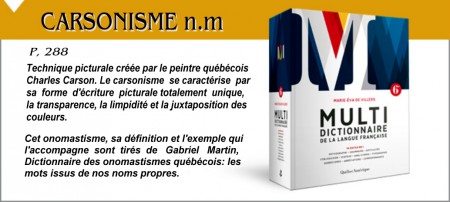
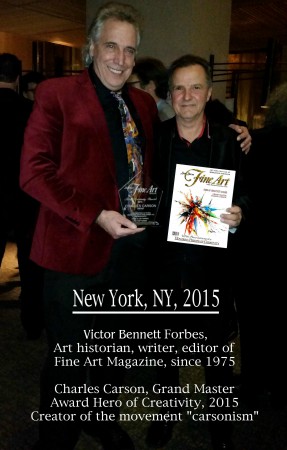
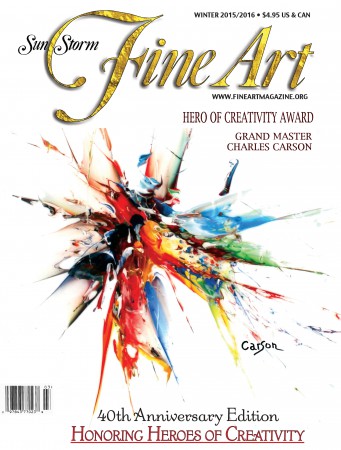
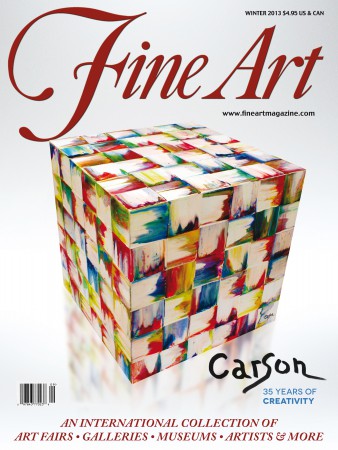
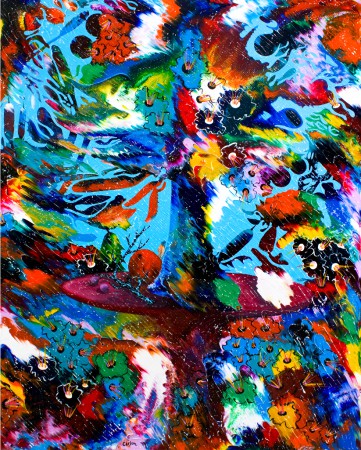
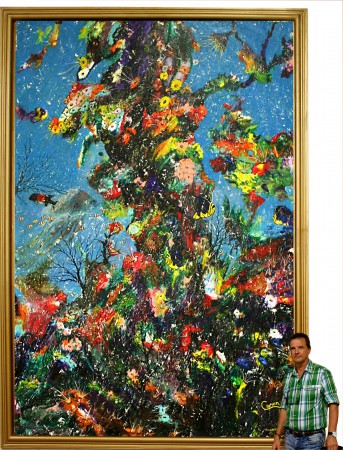
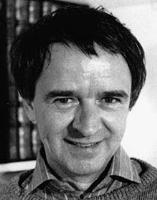
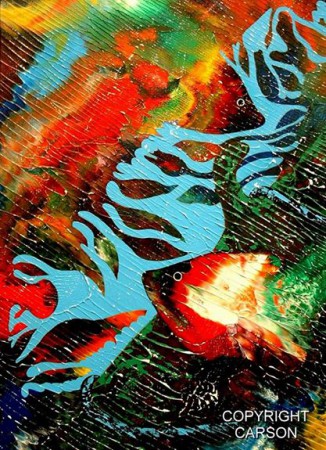
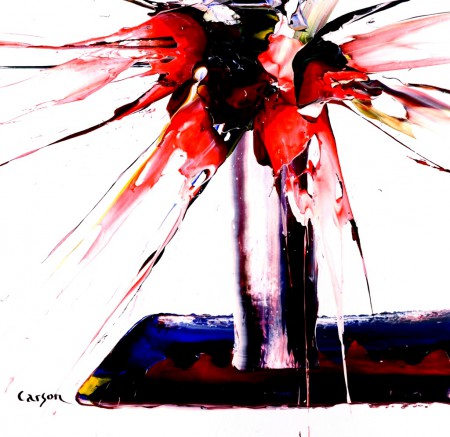
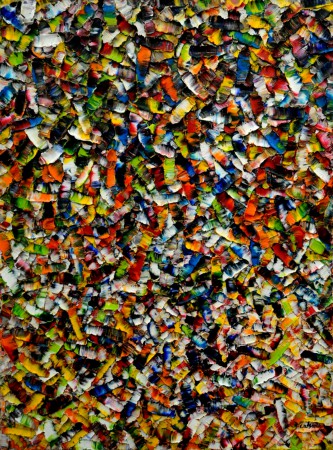
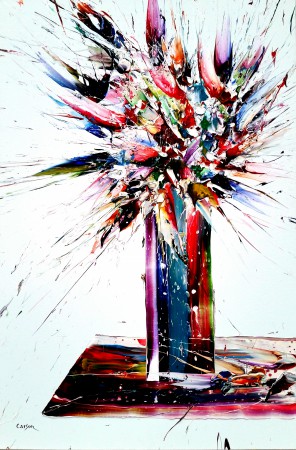
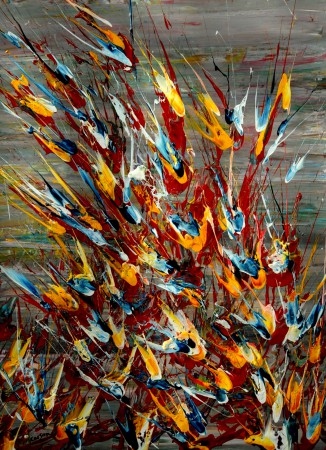
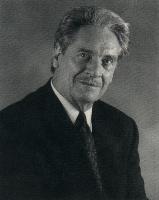
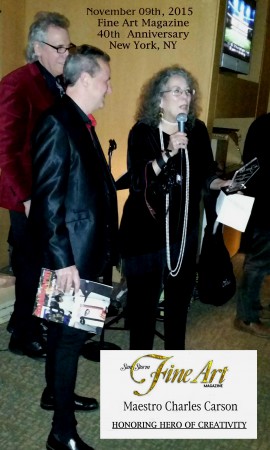
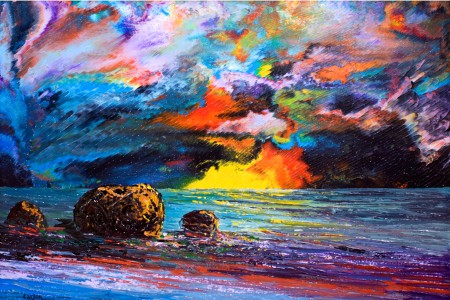
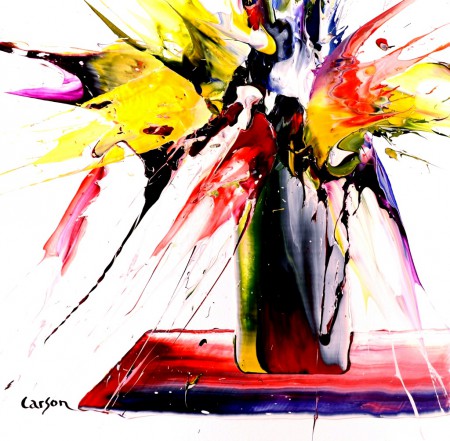
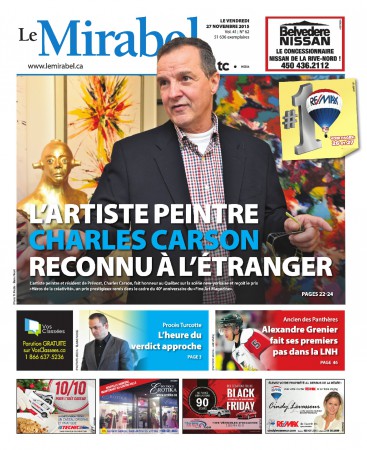
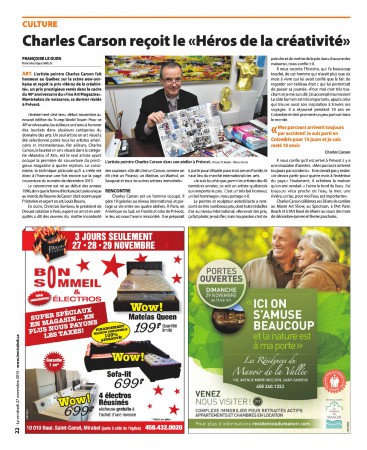
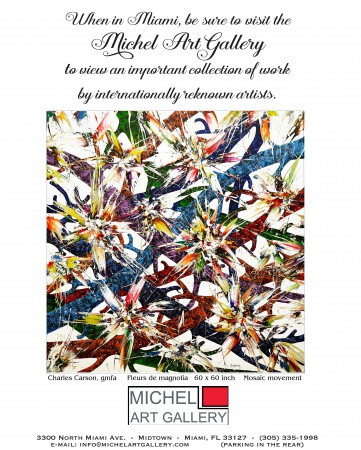
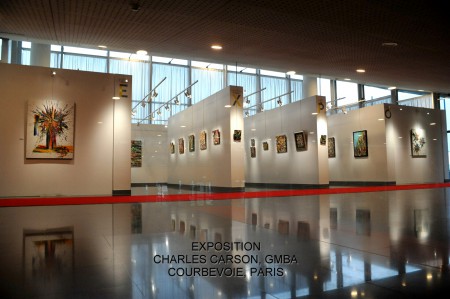
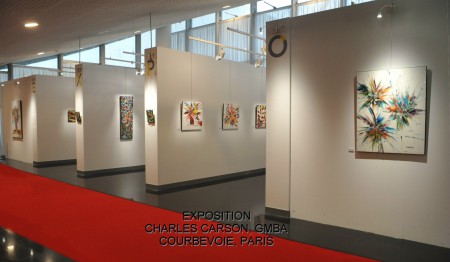
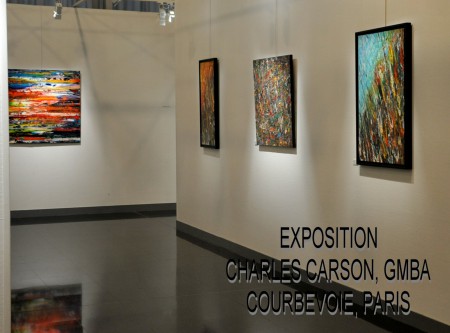
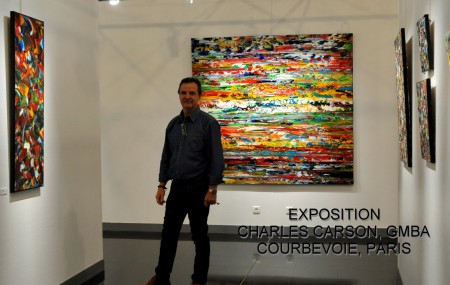
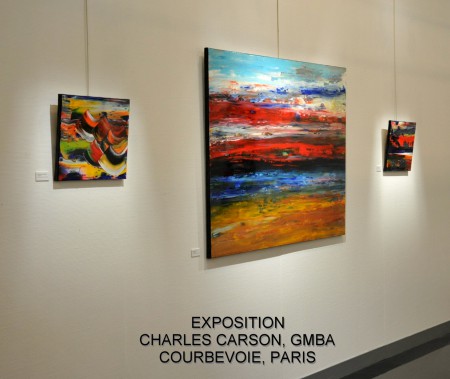
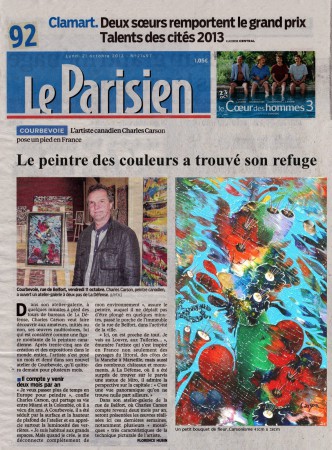
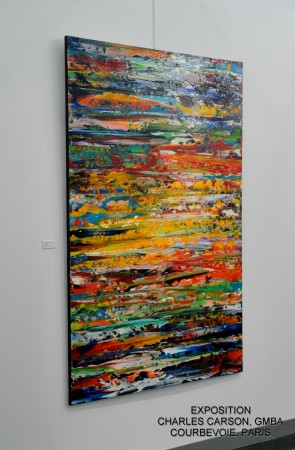
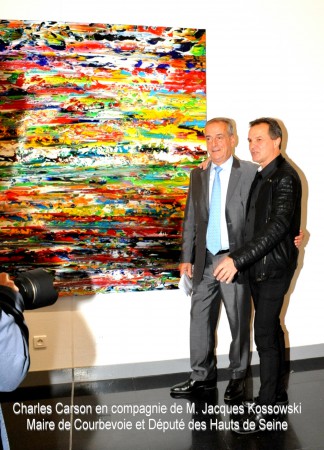
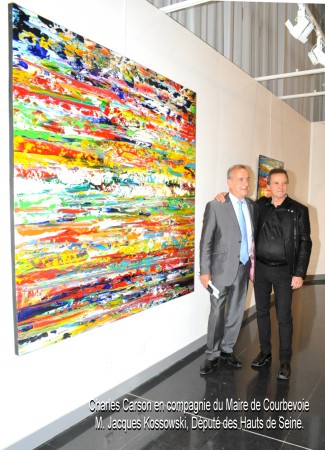
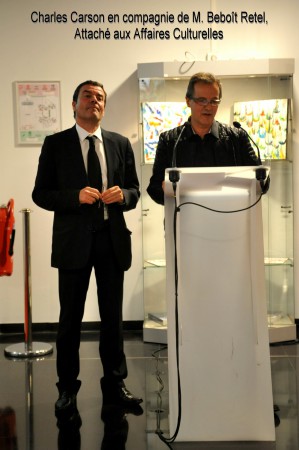
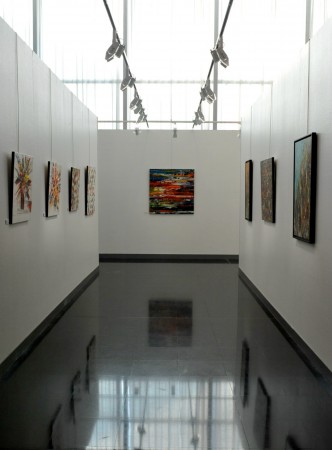
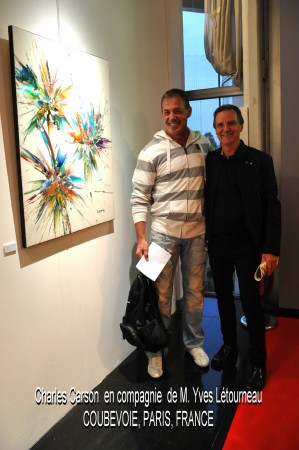
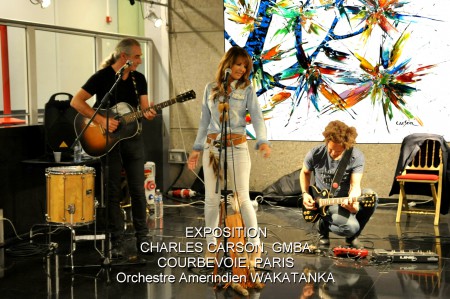
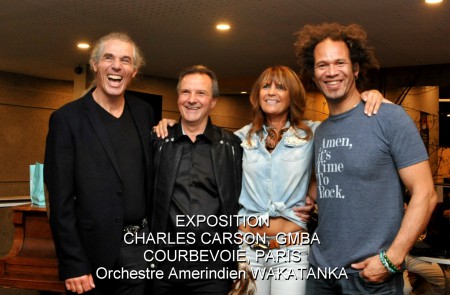
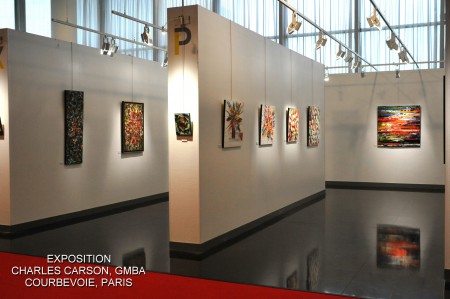
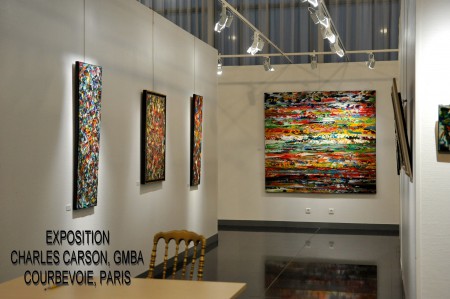
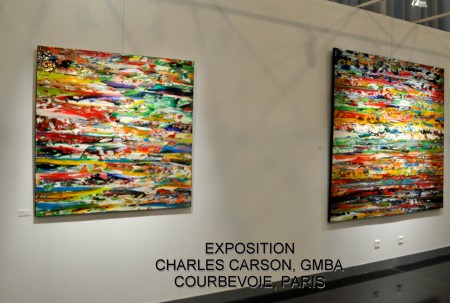
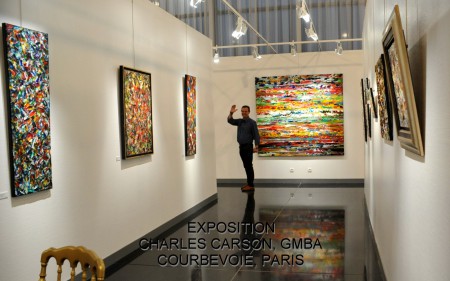
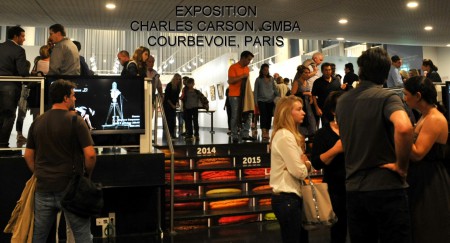
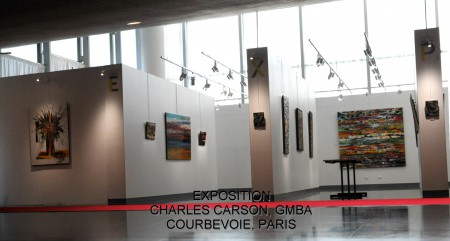
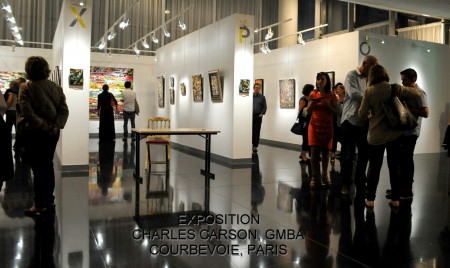
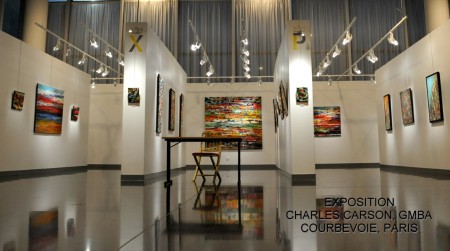
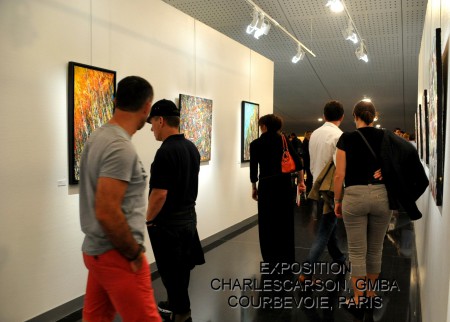
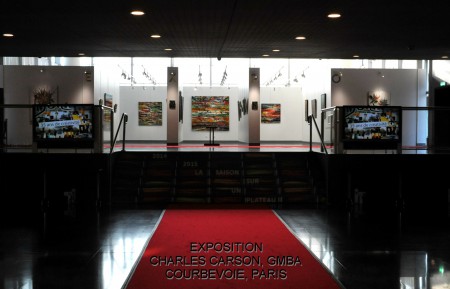
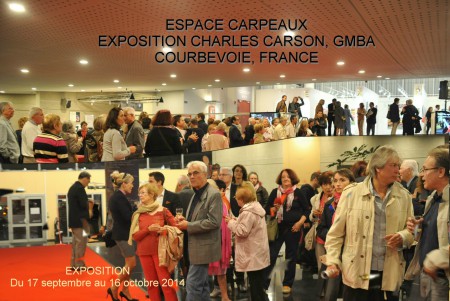
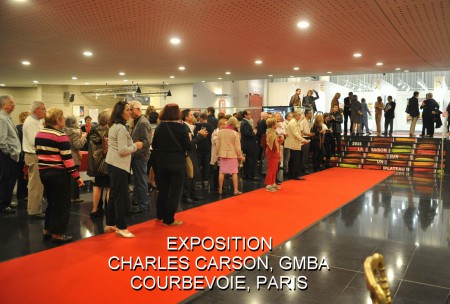
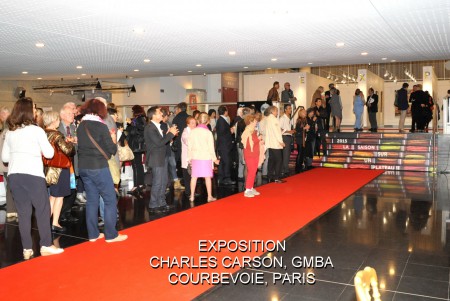
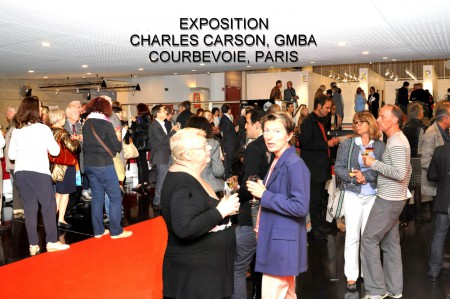
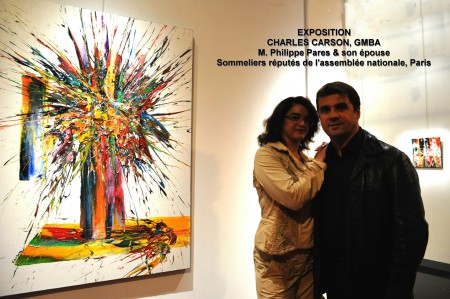
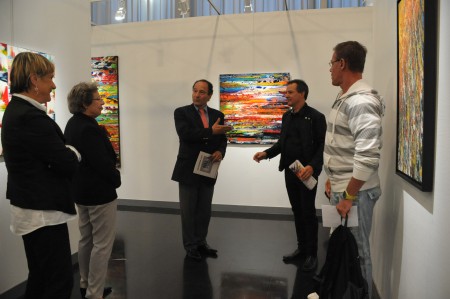
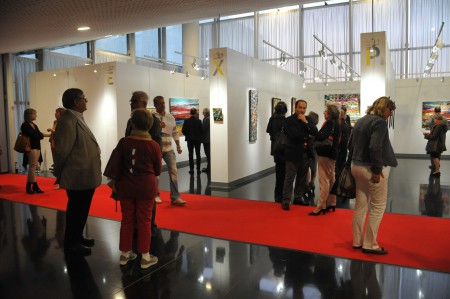
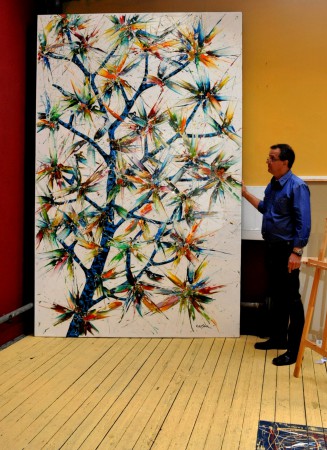
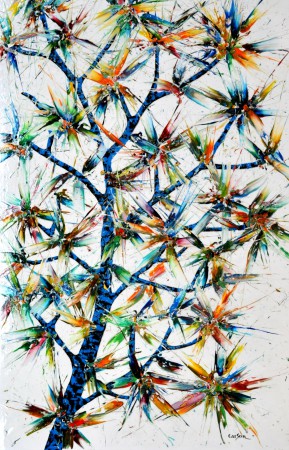
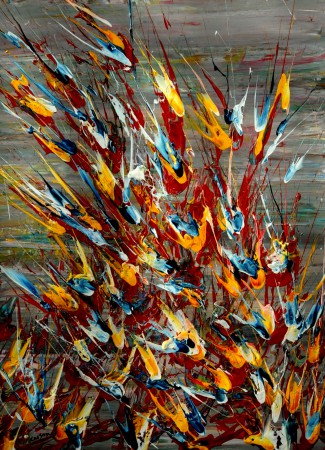
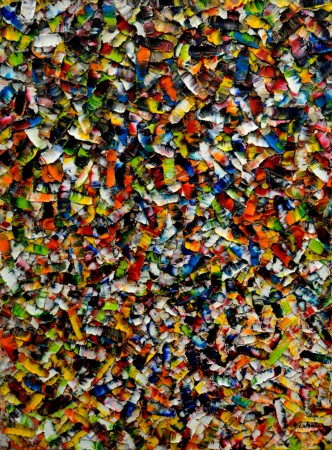
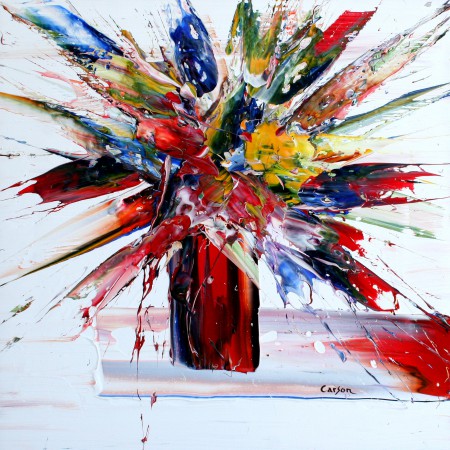
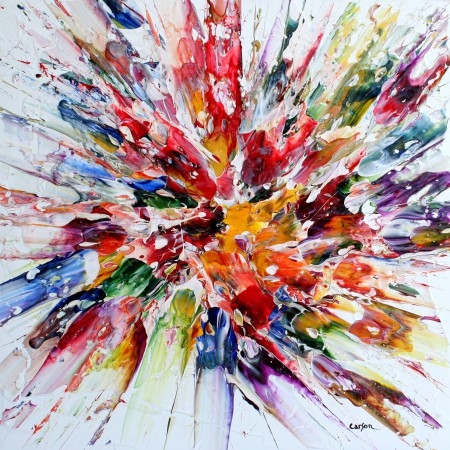
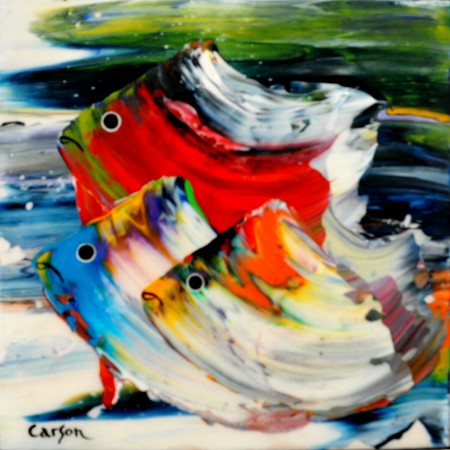
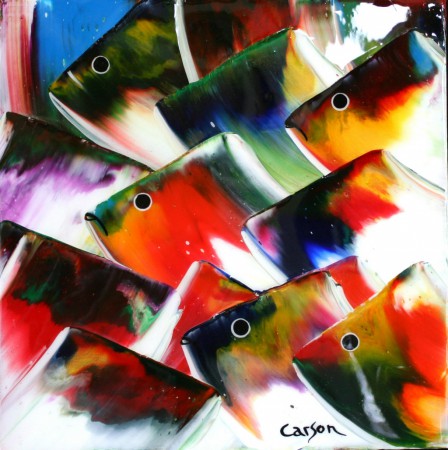
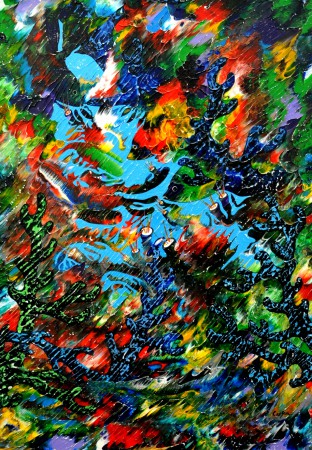
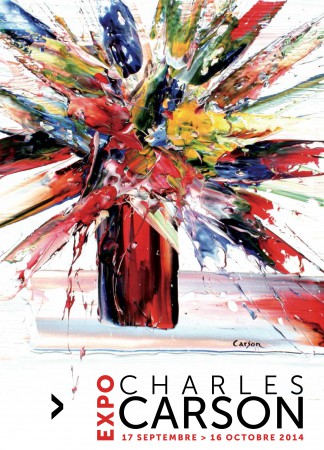
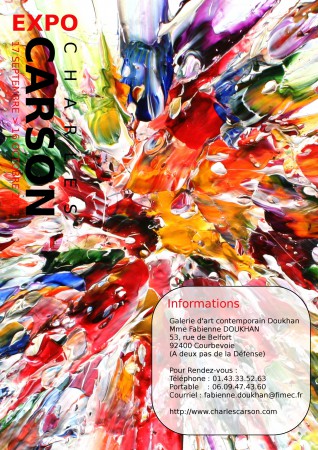
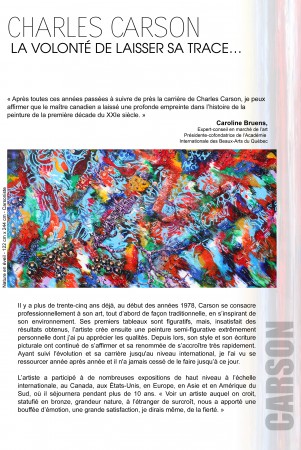
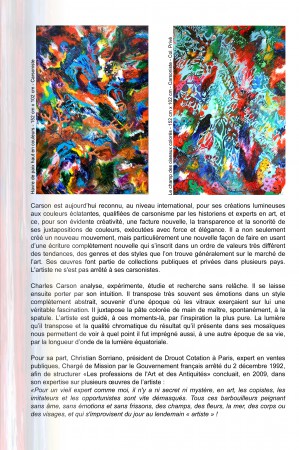
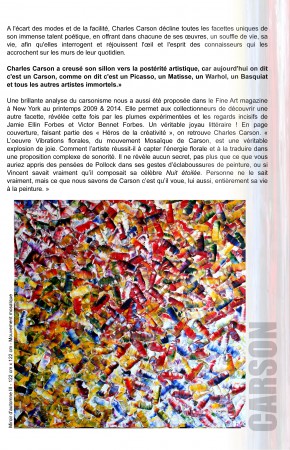
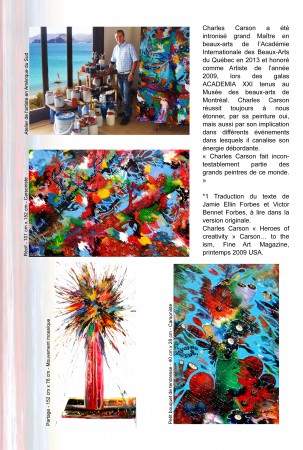
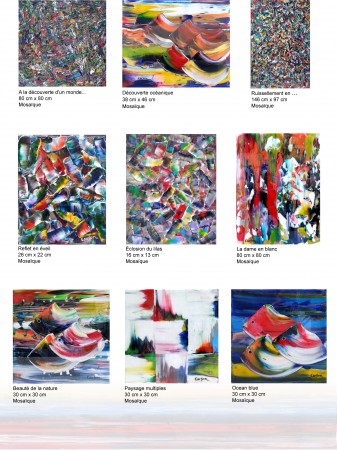
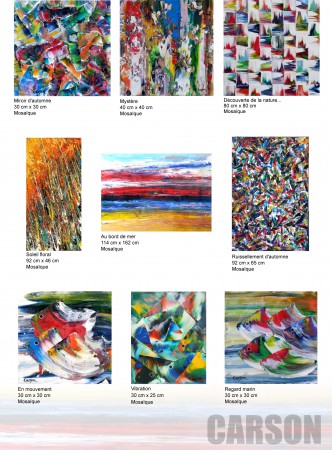
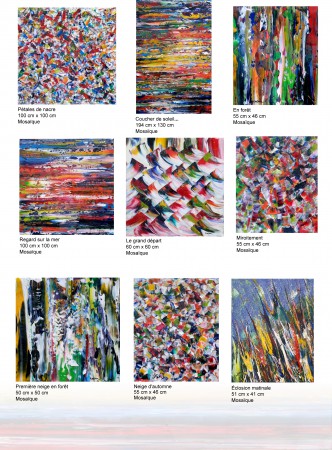
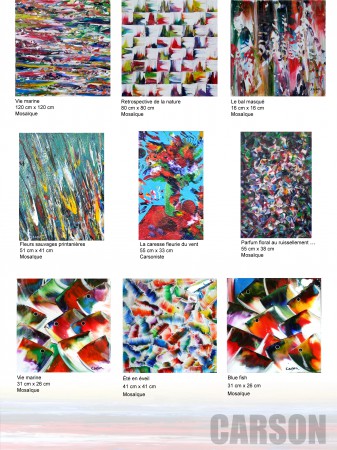
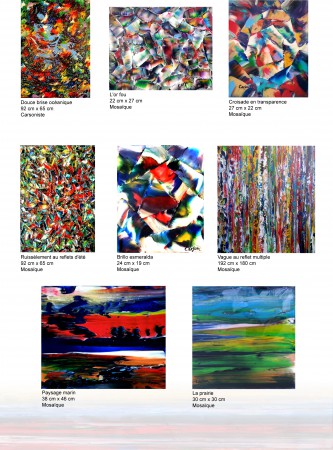
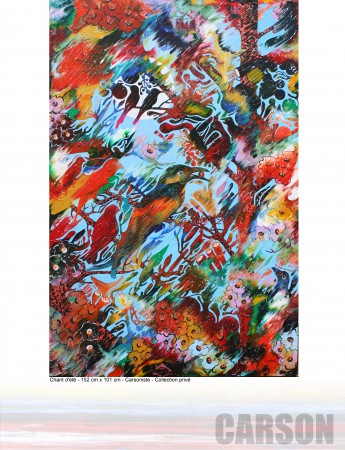
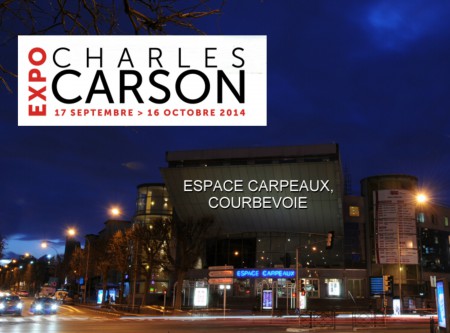
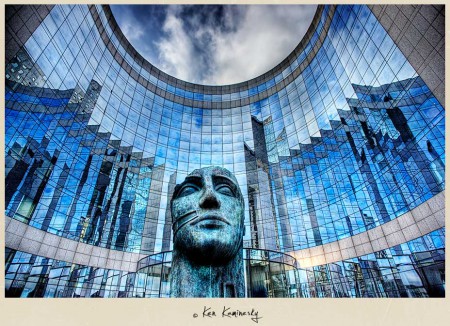
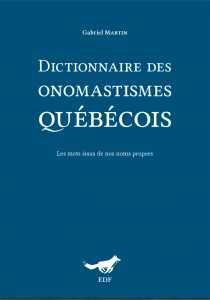
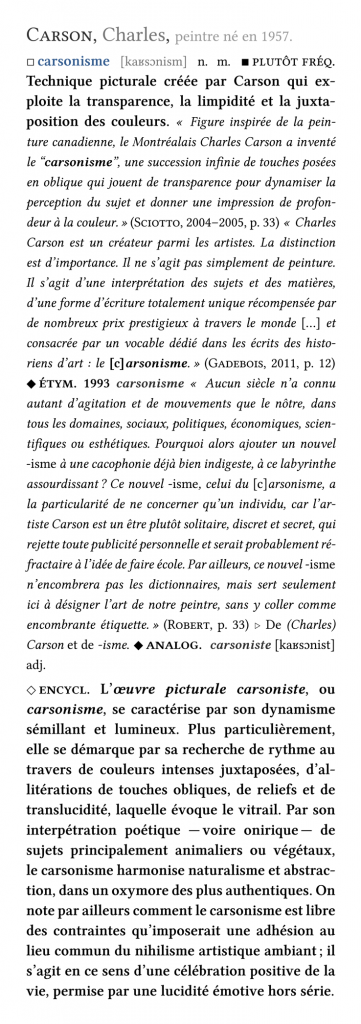
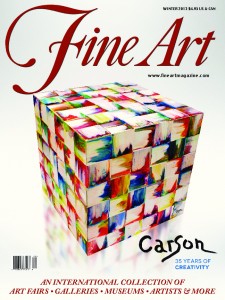
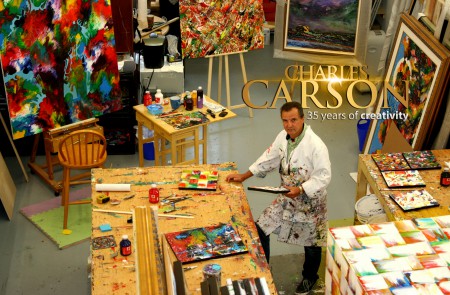
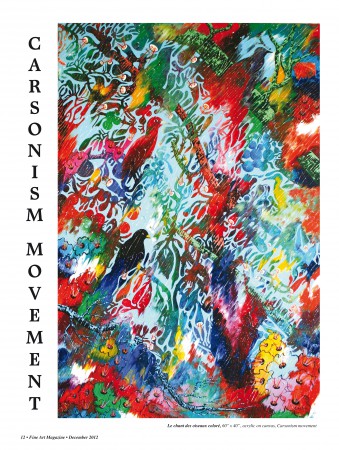
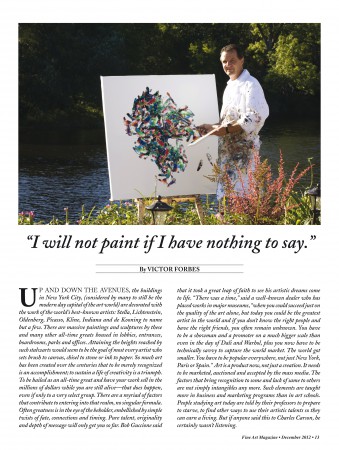
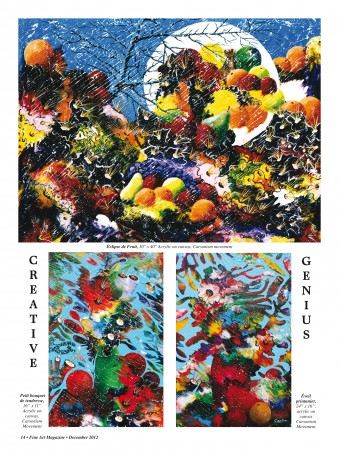
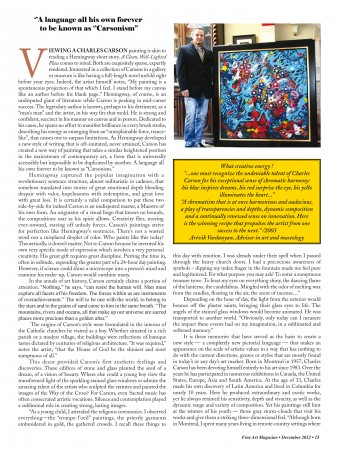
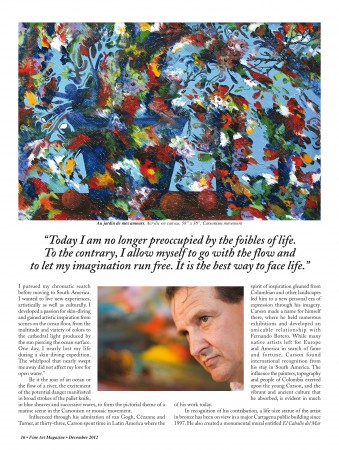
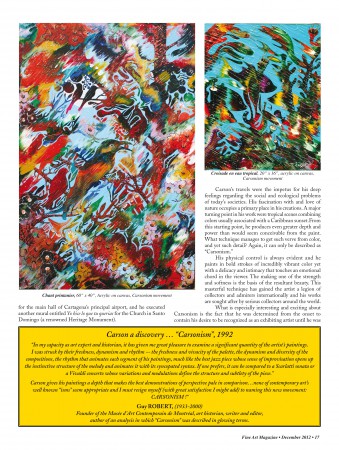
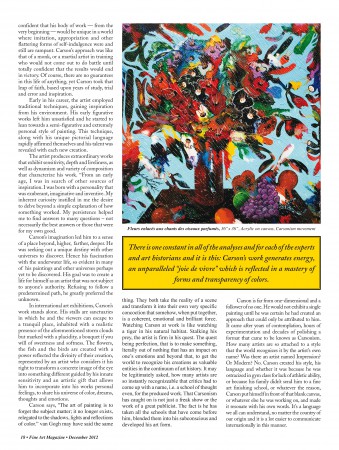
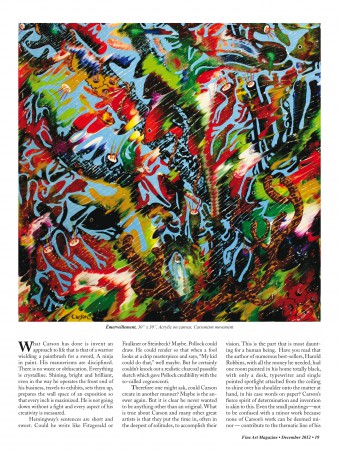
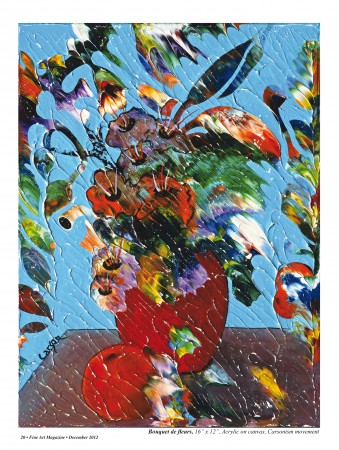
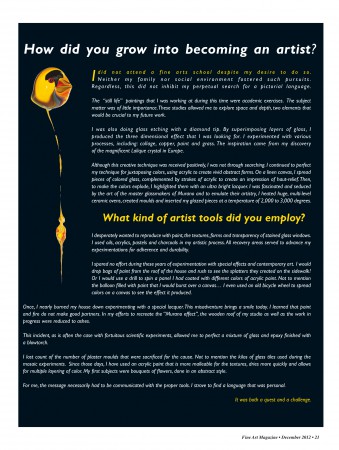
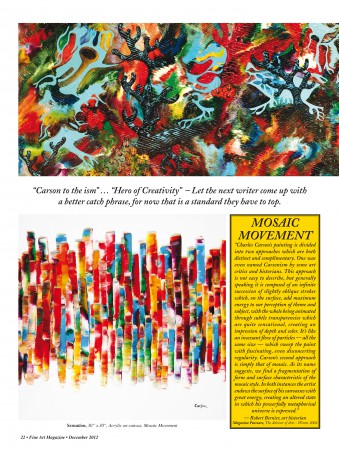
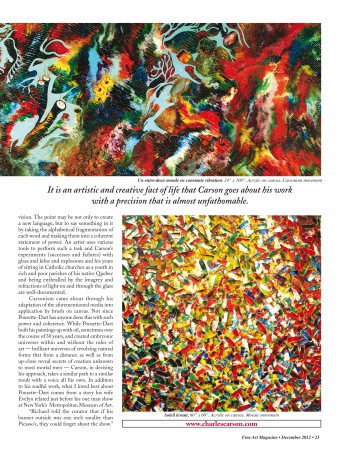
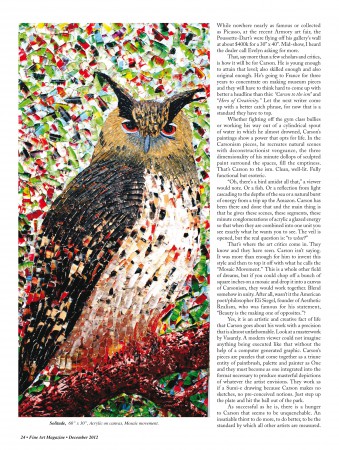
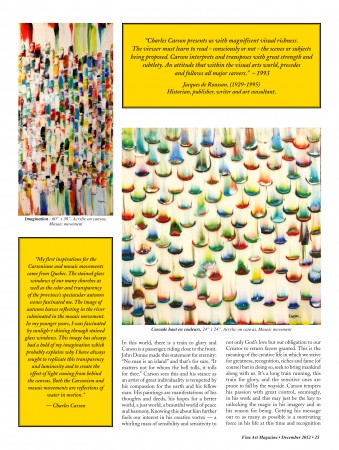 lass etching with a diamond tip. By superimposing layers of glass, I produced the three dimensional effect that I was looking for. I experimented with various processes, including: collage, copper, paint and grass. The inspiration came from my discoveryof the magnificent Lalique crystal in Europe.
lass etching with a diamond tip. By superimposing layers of glass, I produced the three dimensional effect that I was looking for. I experimented with various processes, including: collage, copper, paint and grass. The inspiration came from my discoveryof the magnificent Lalique crystal in Europe.